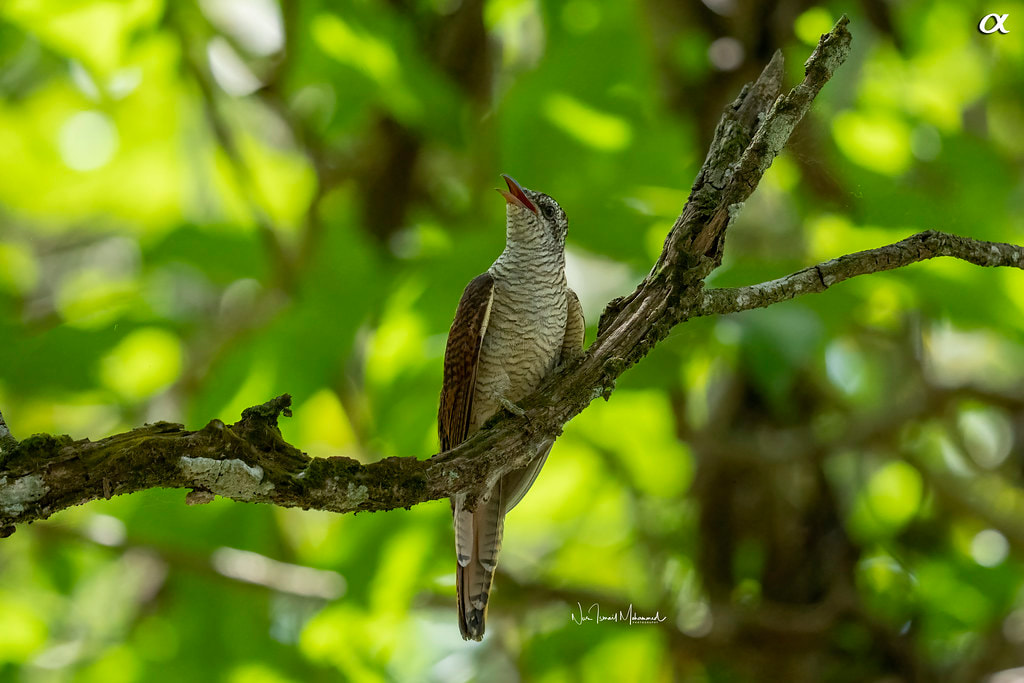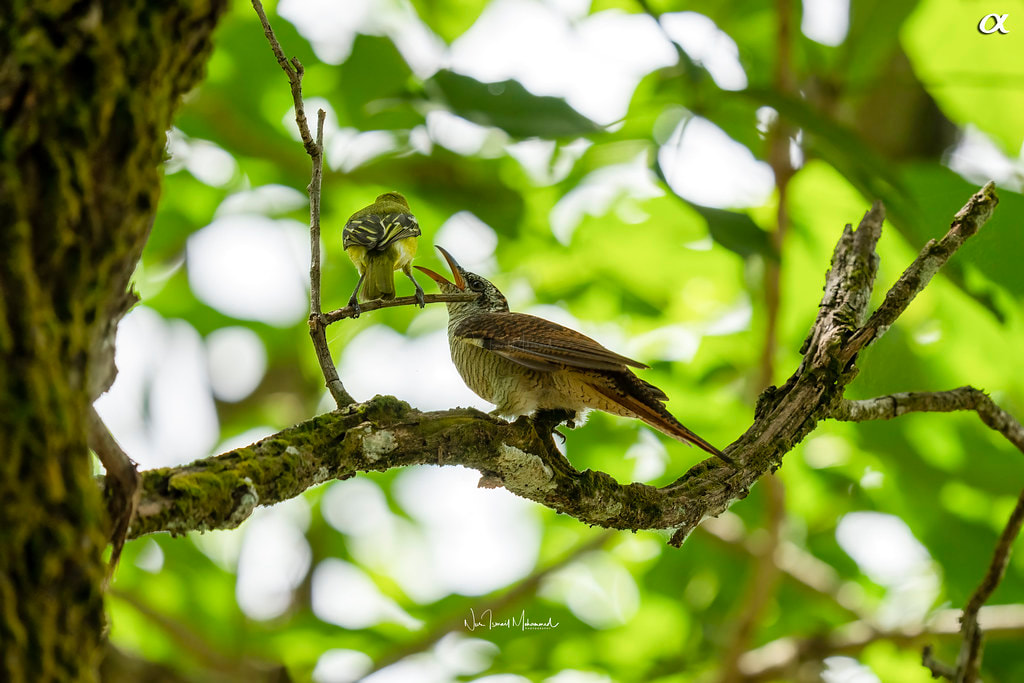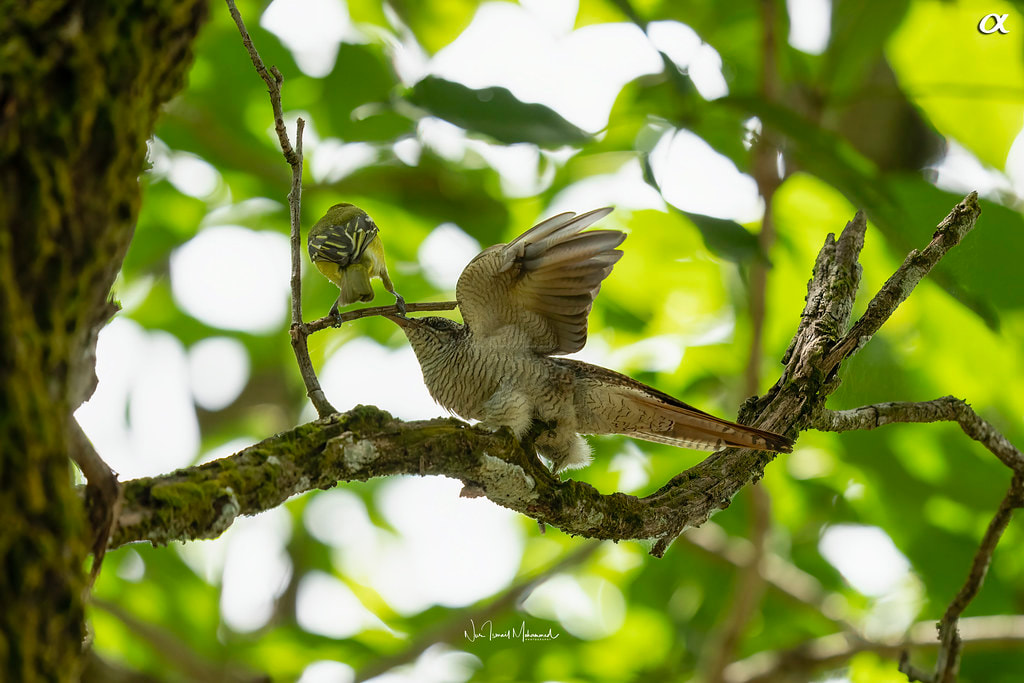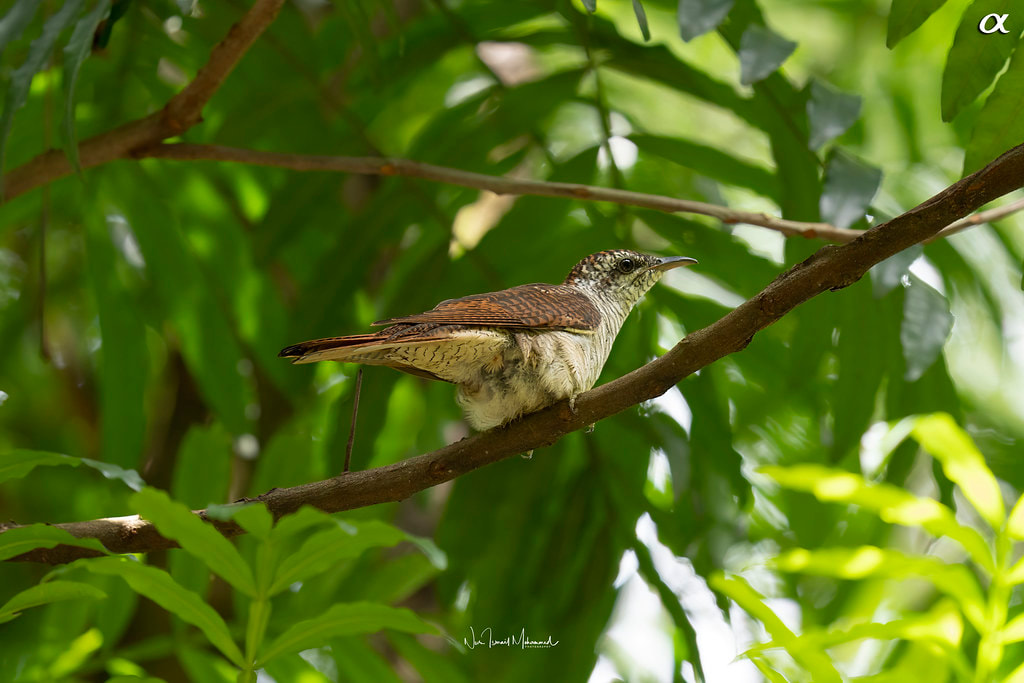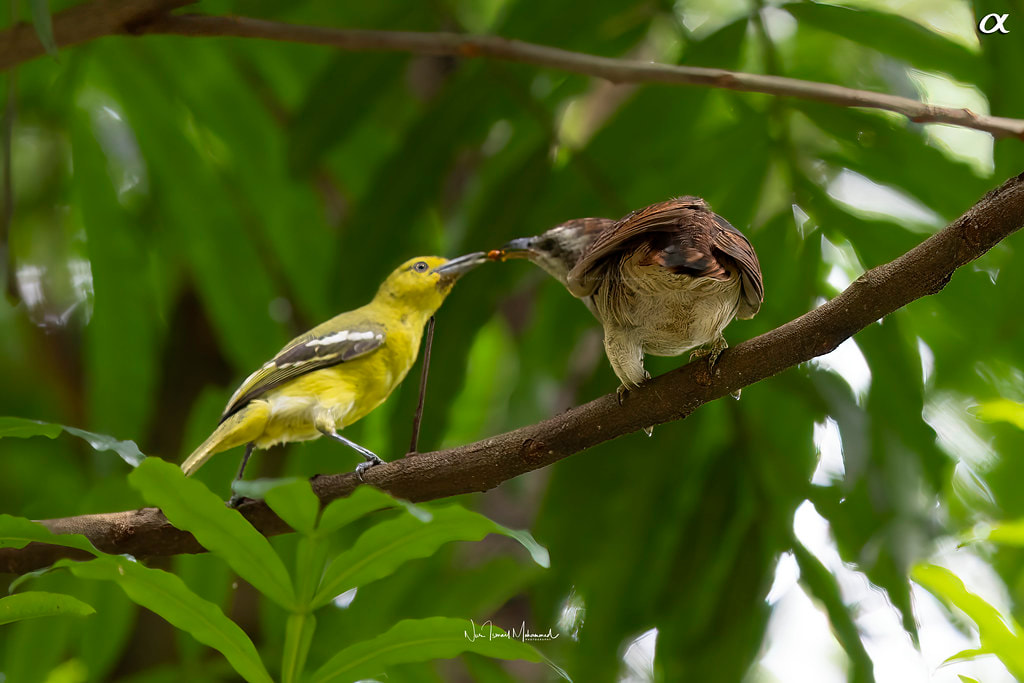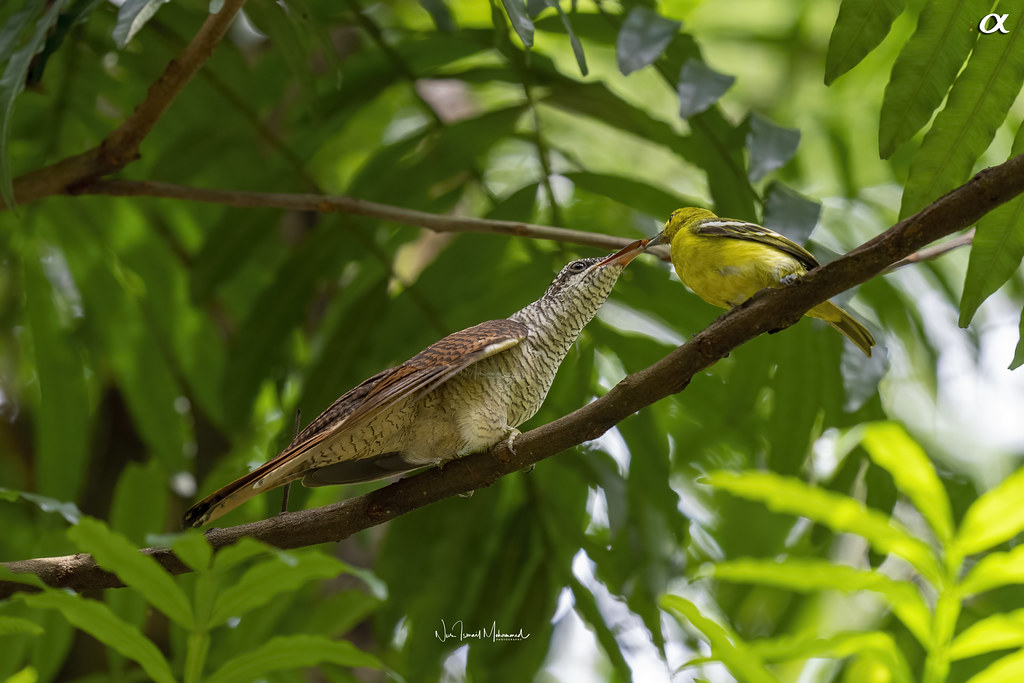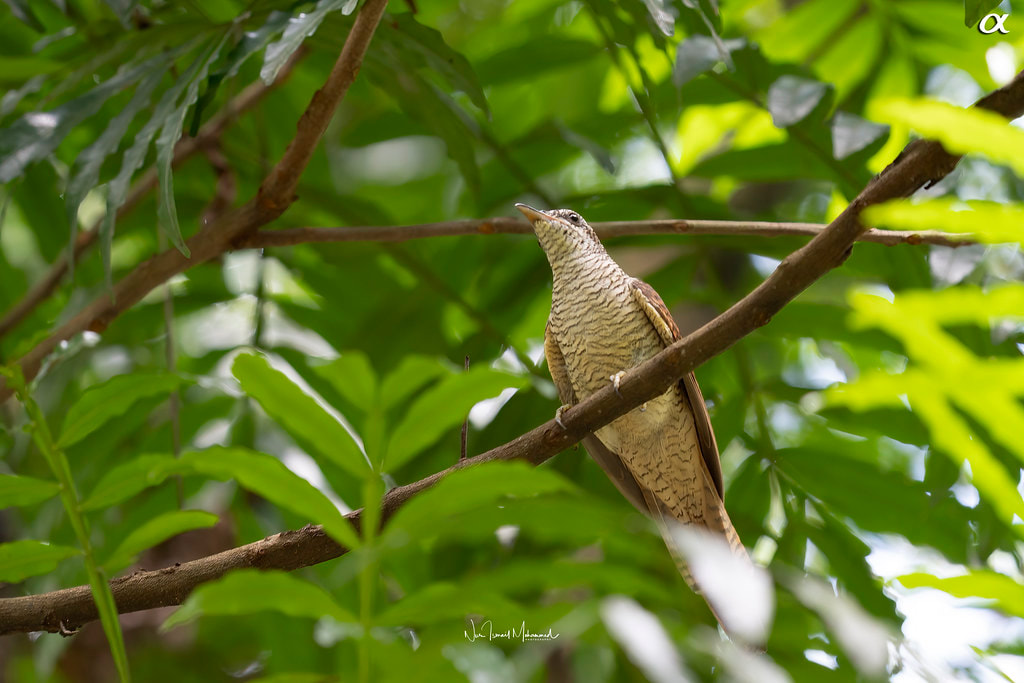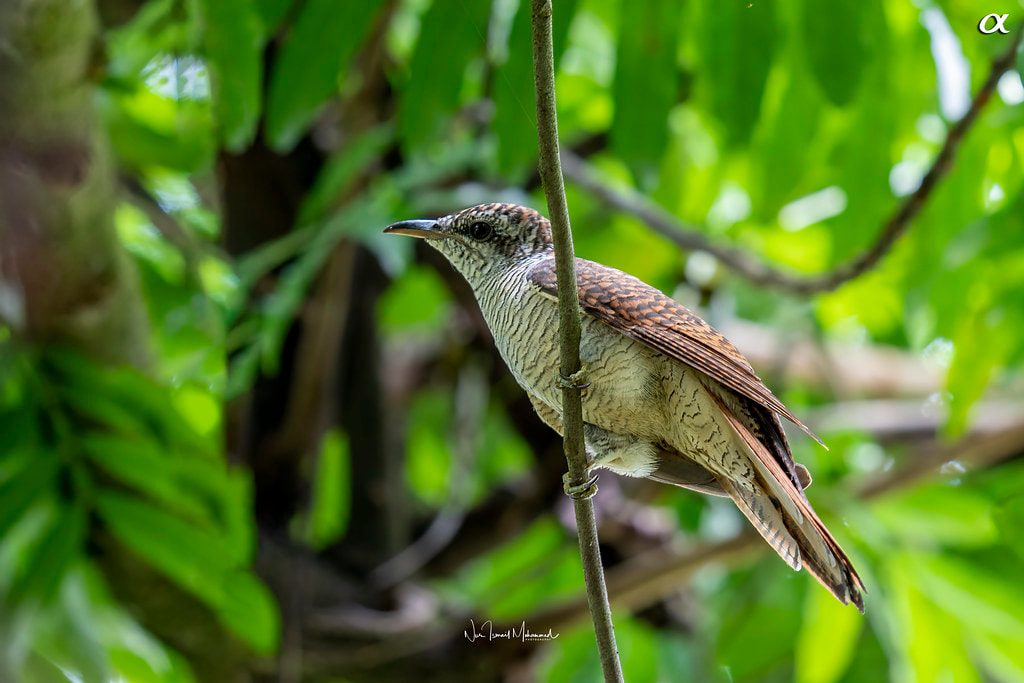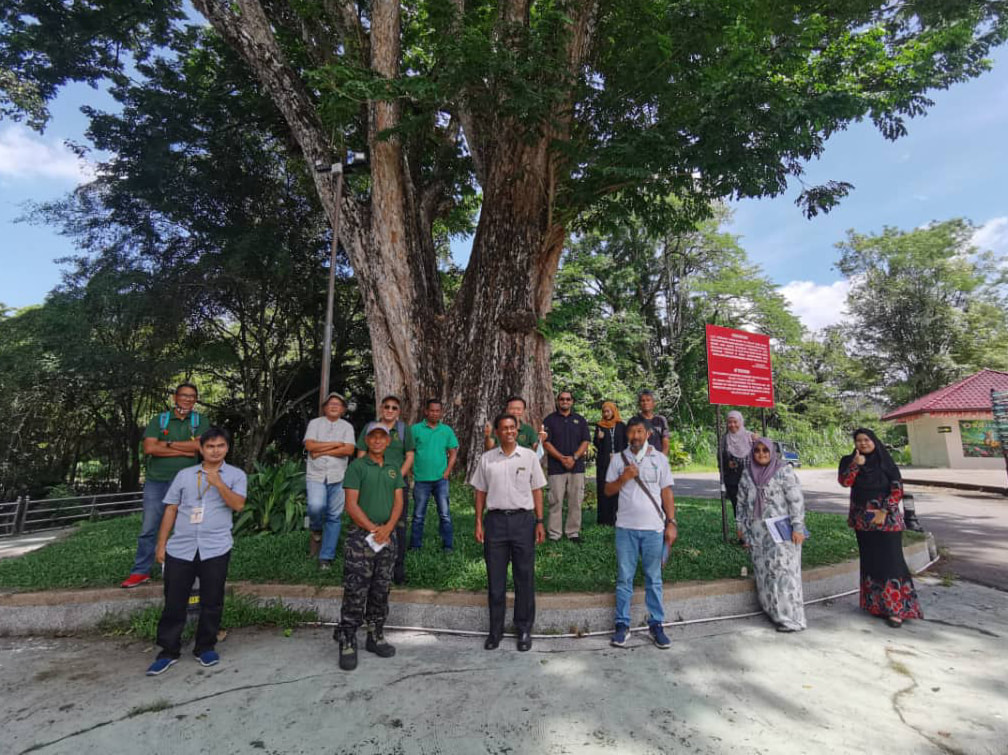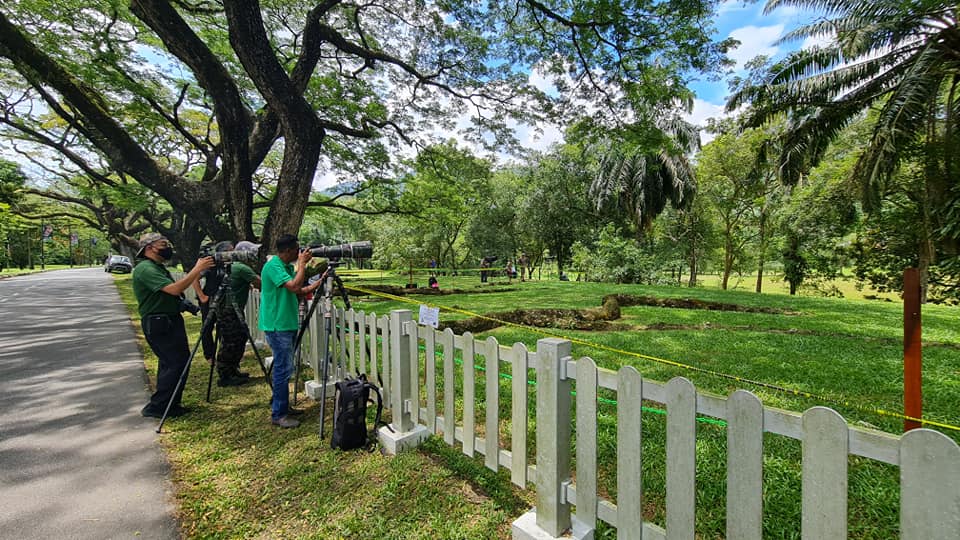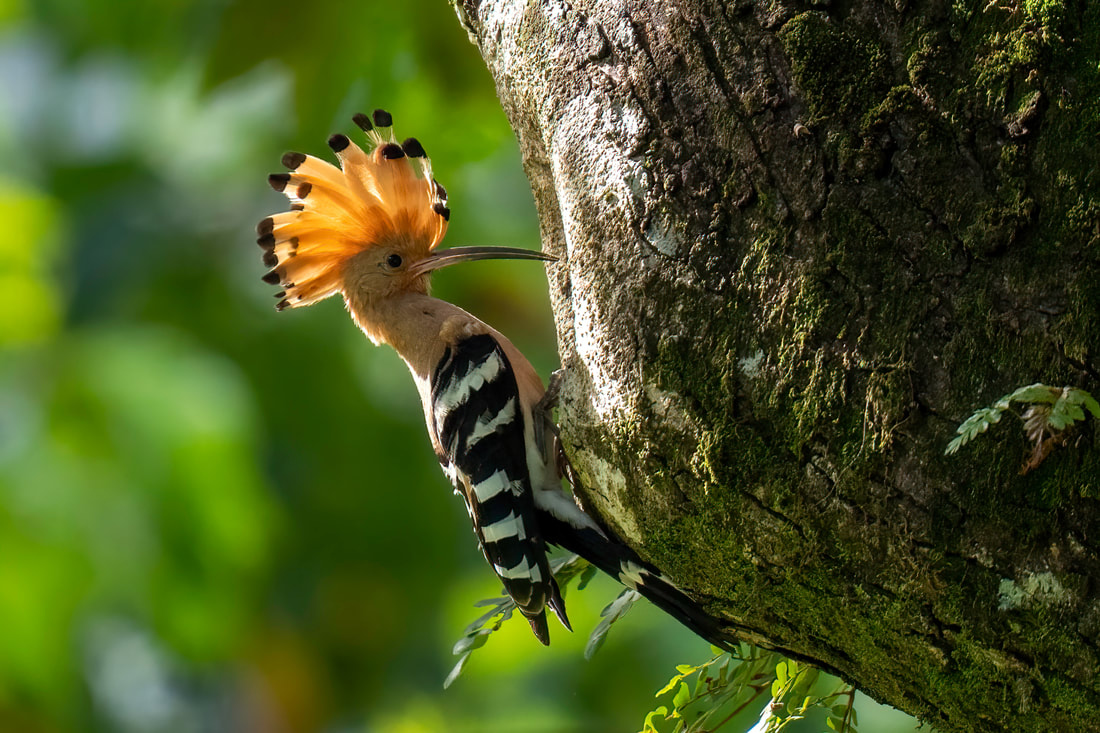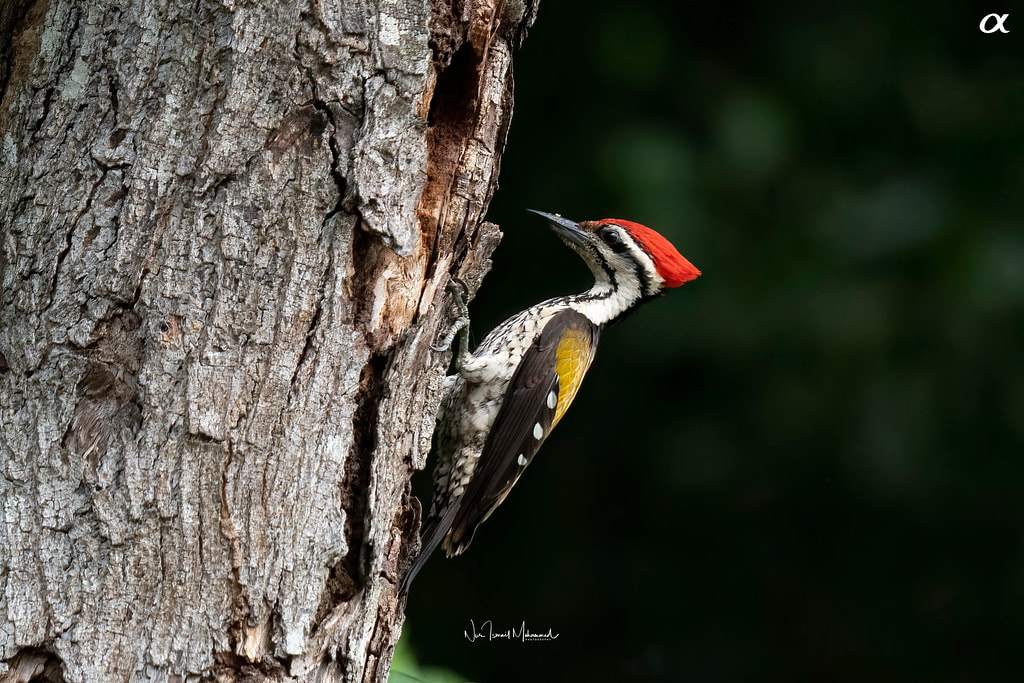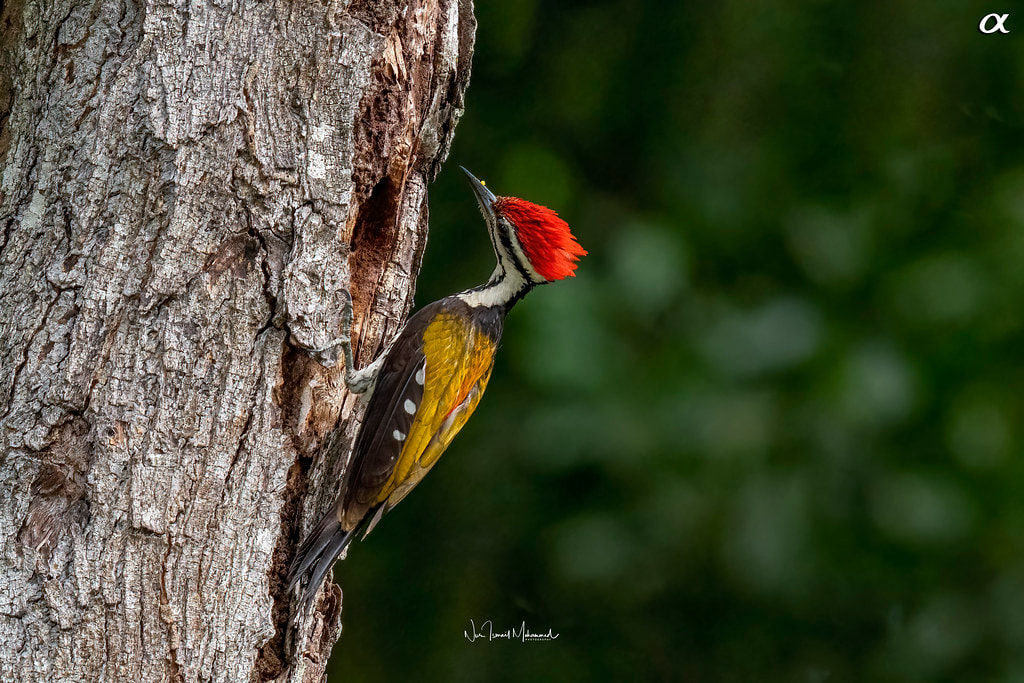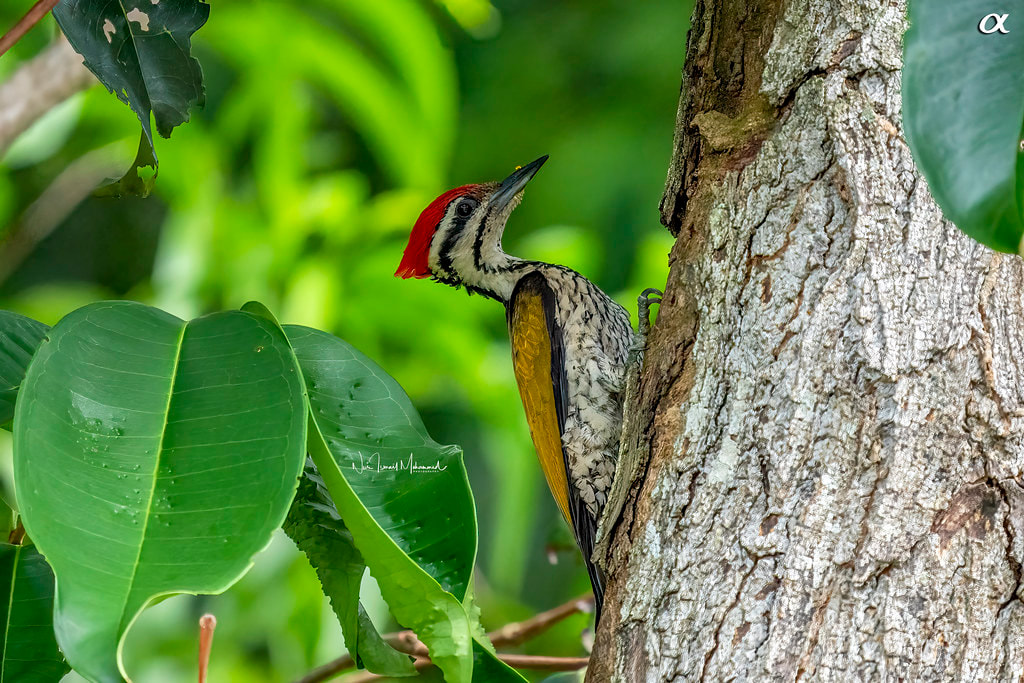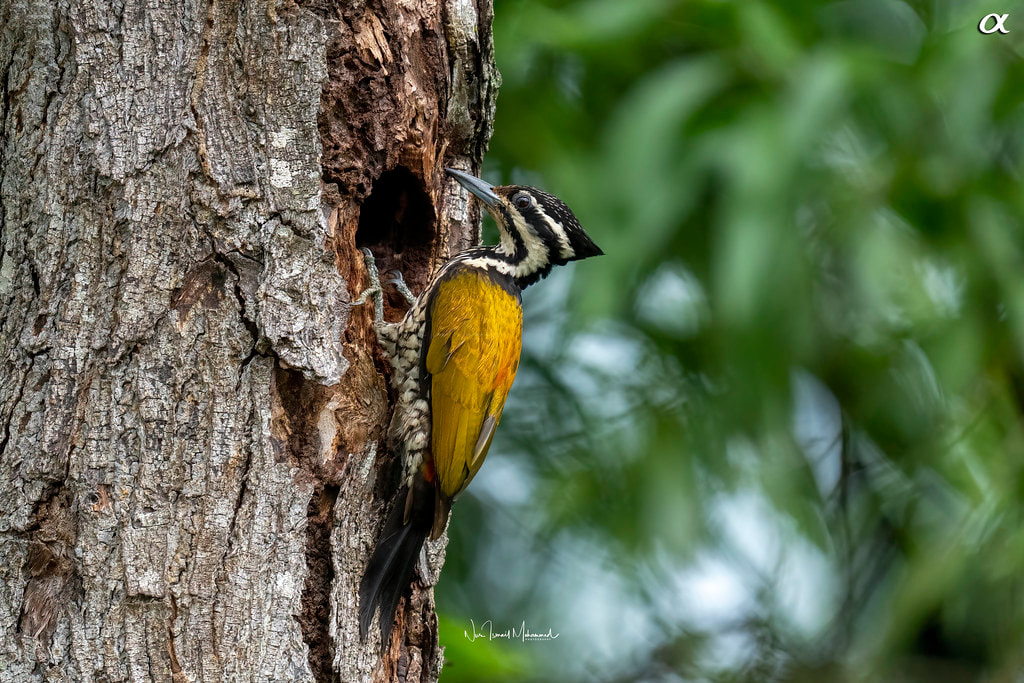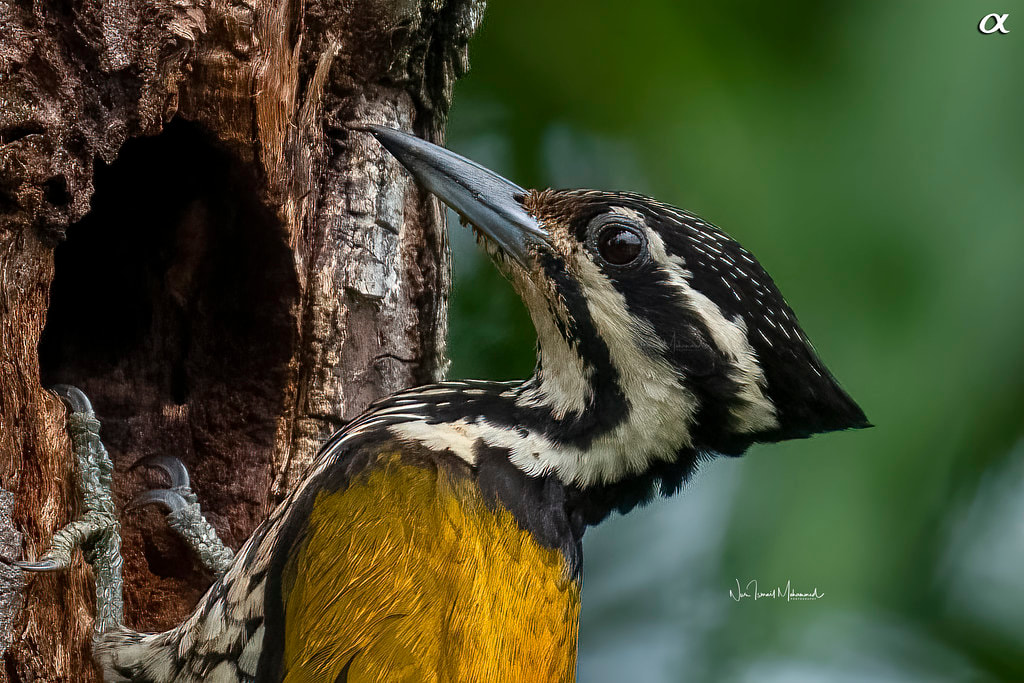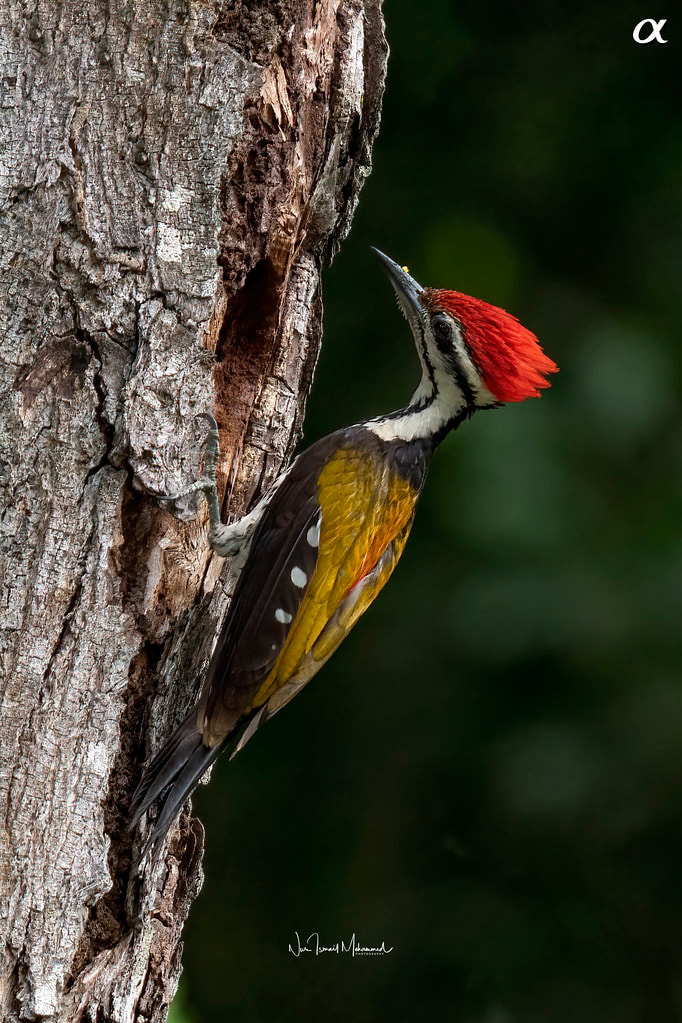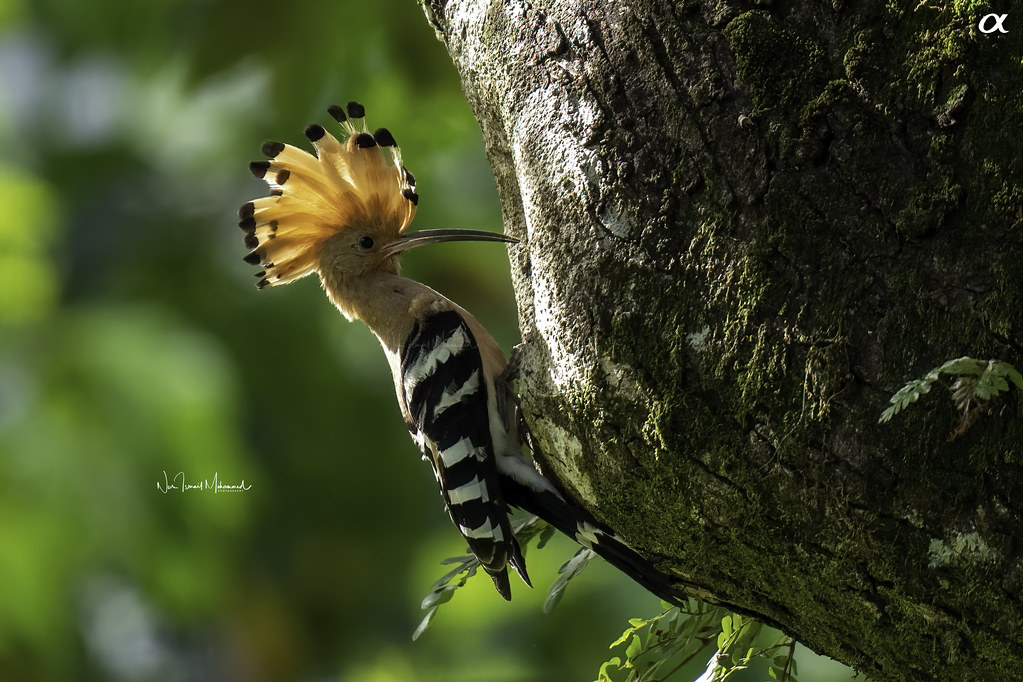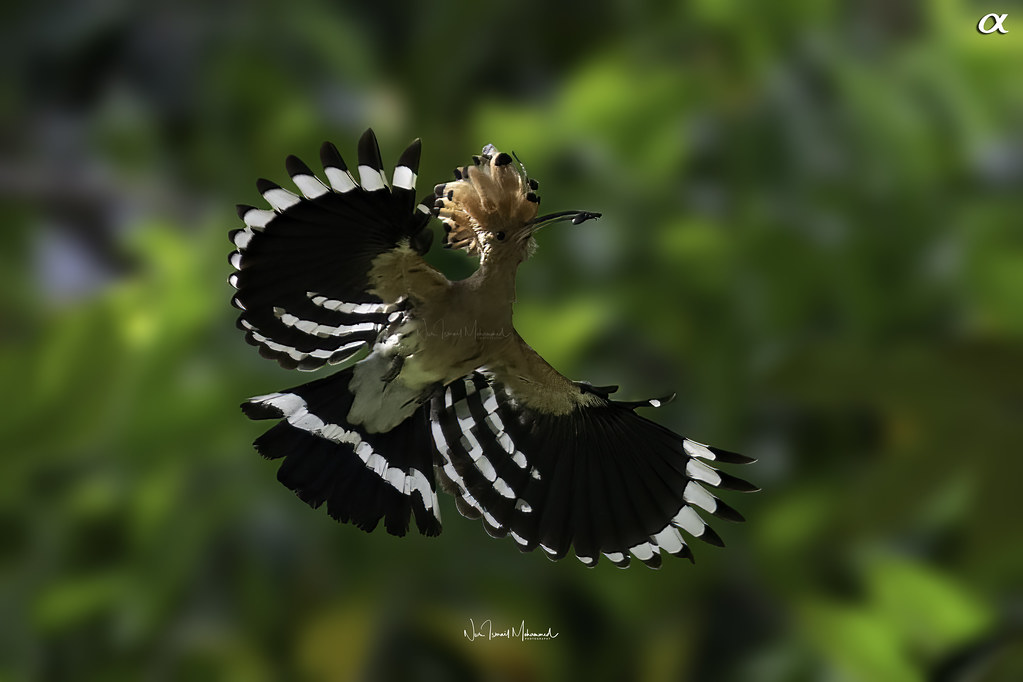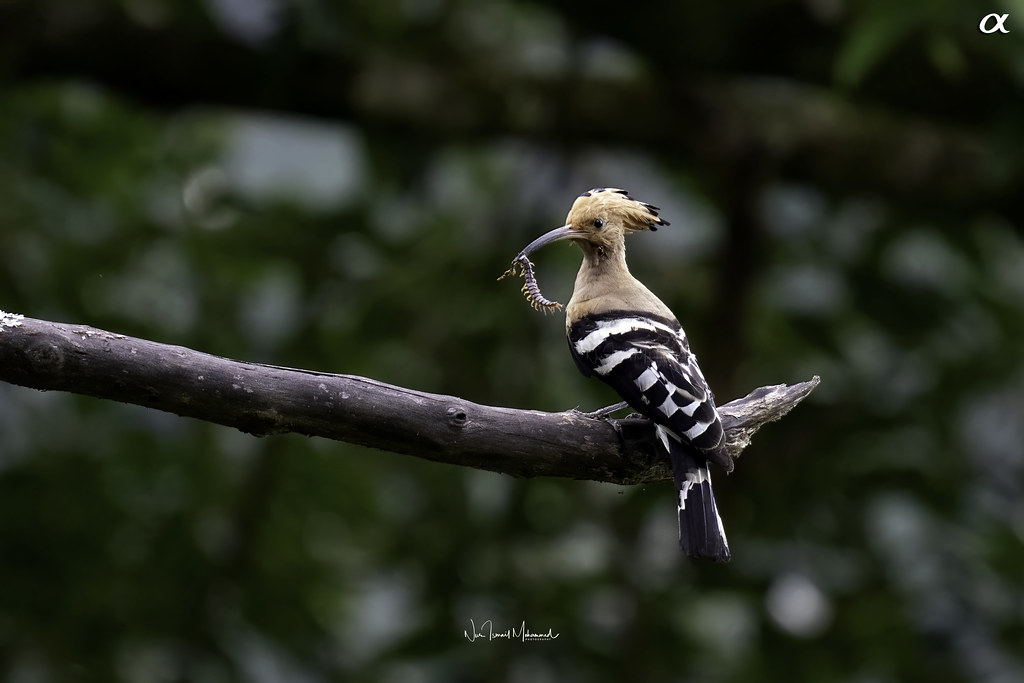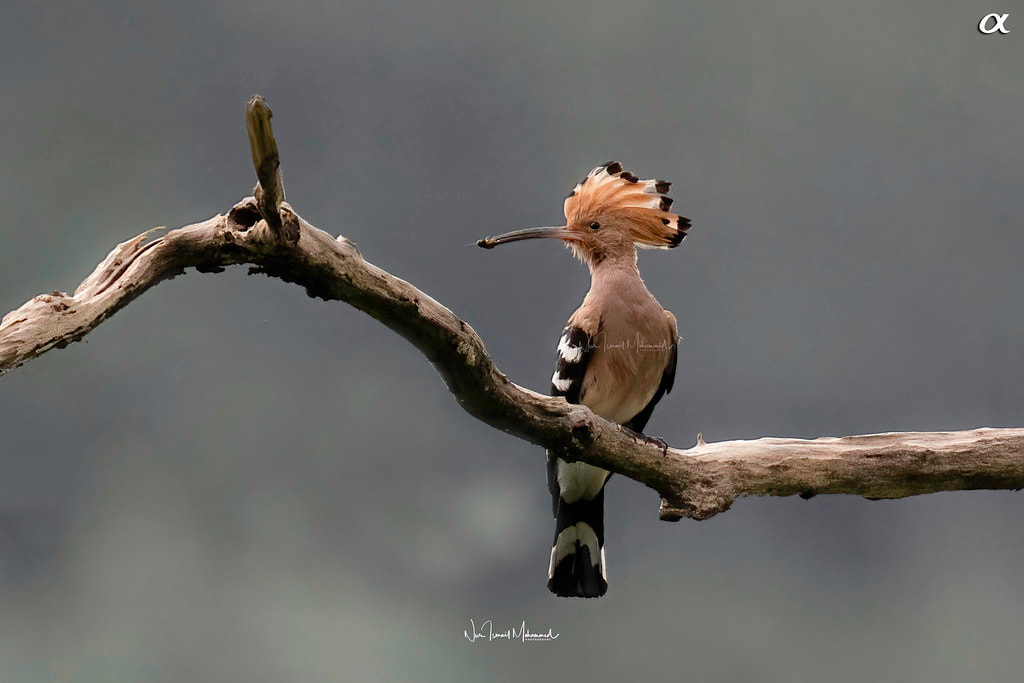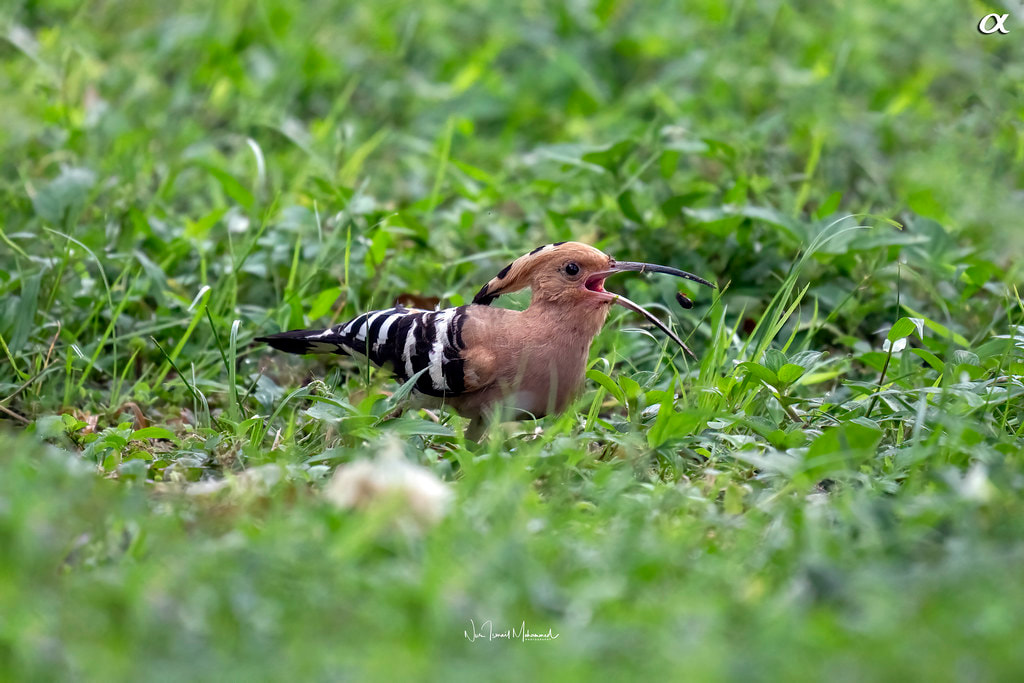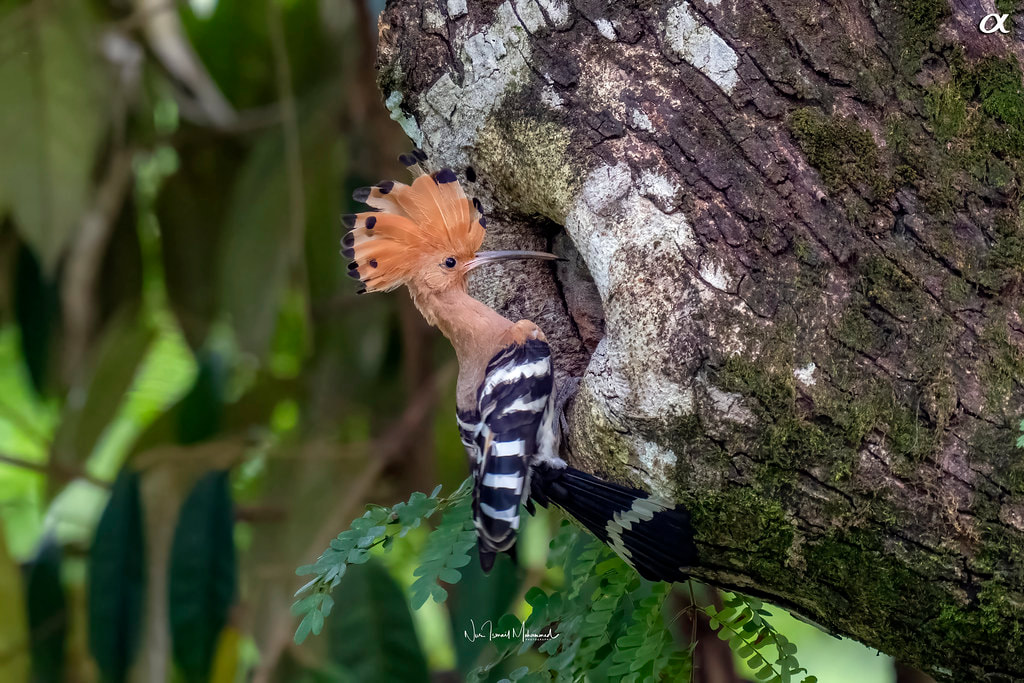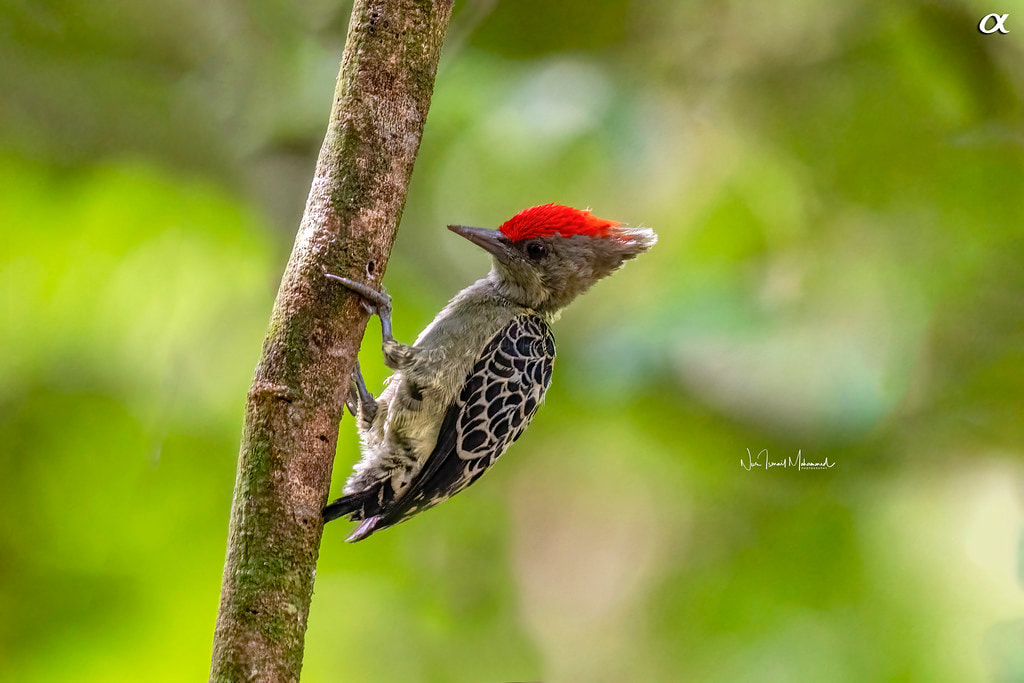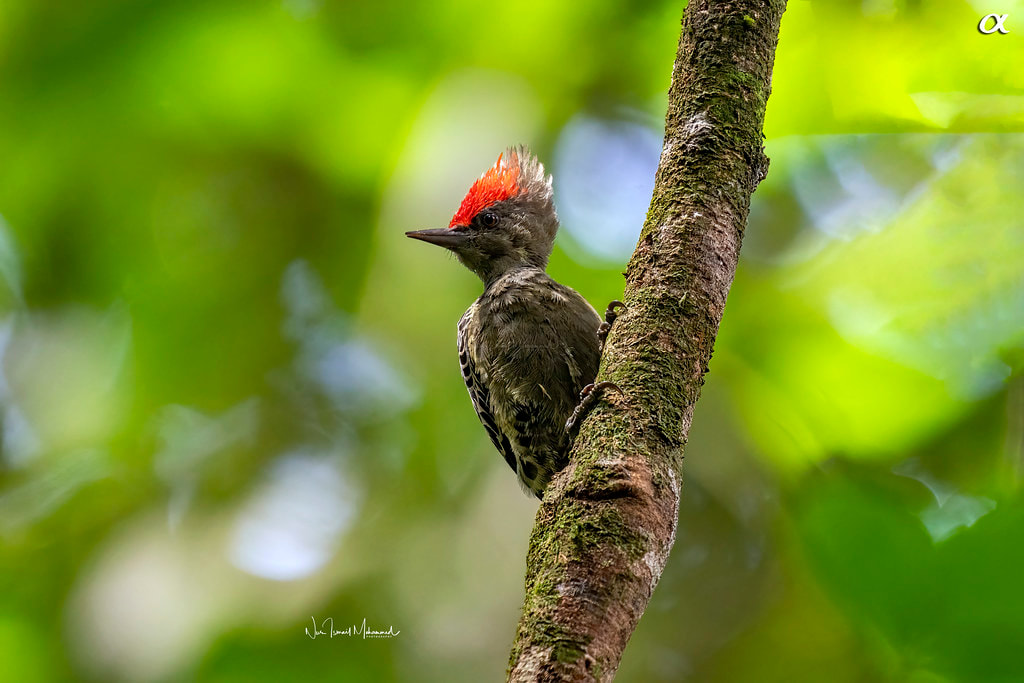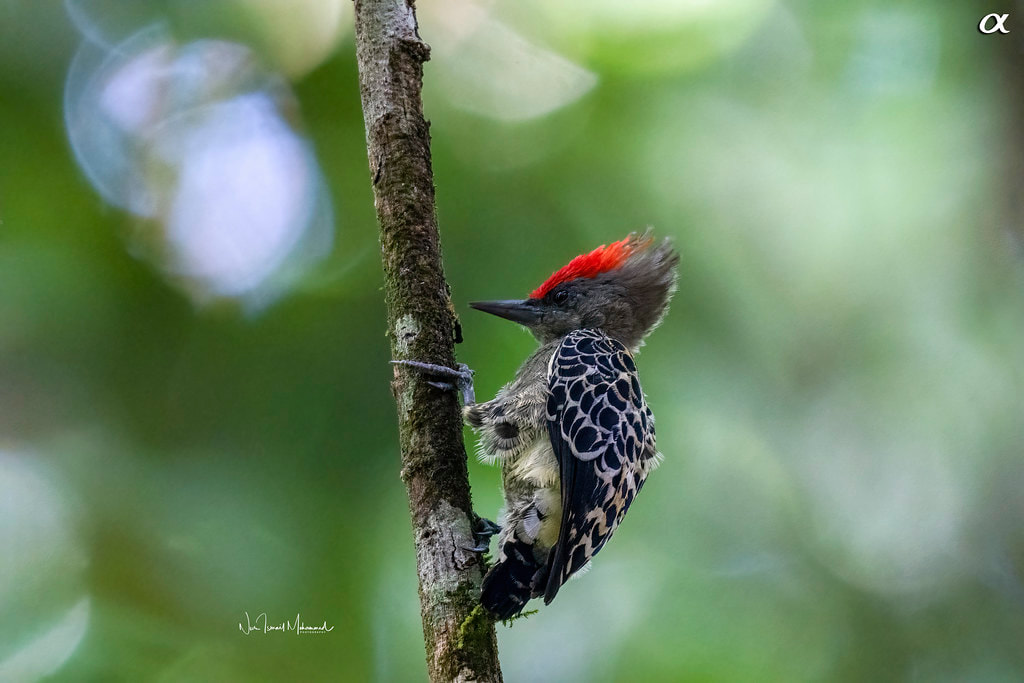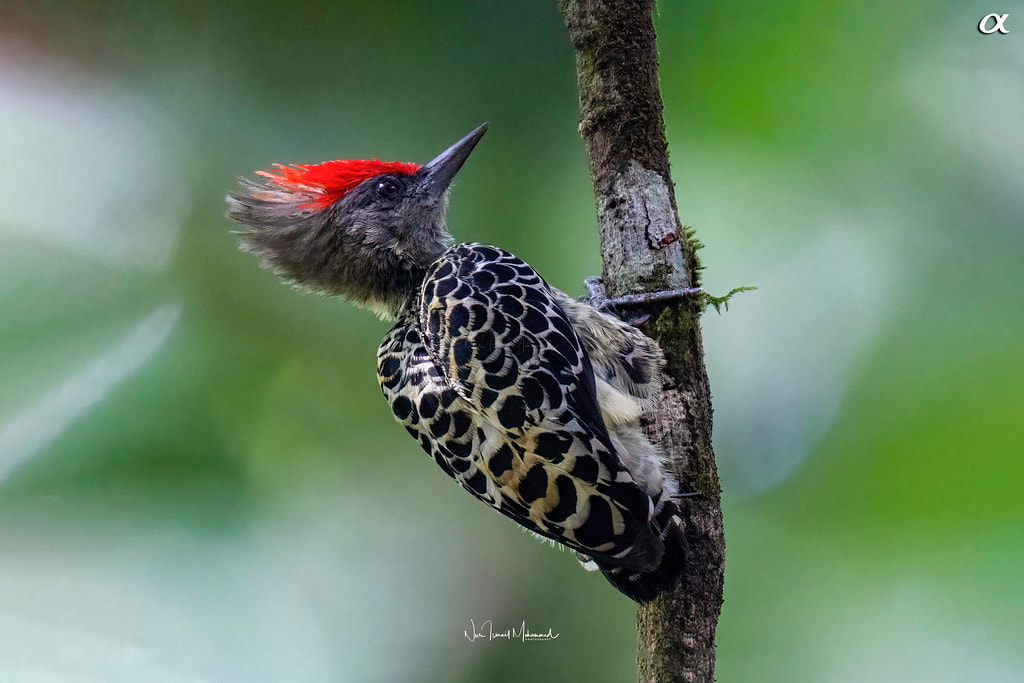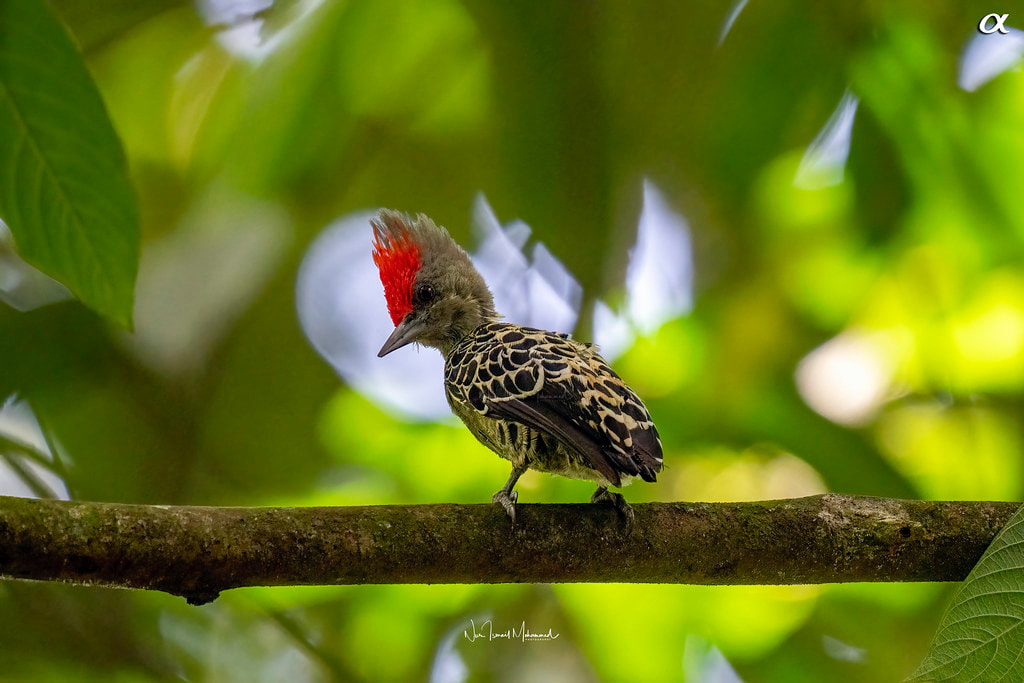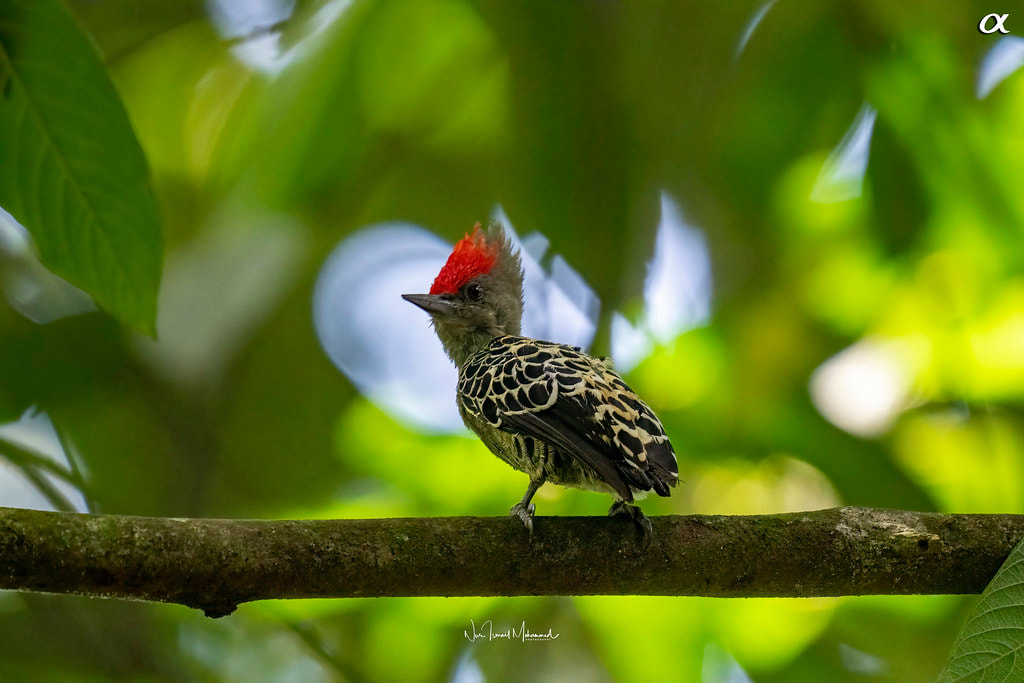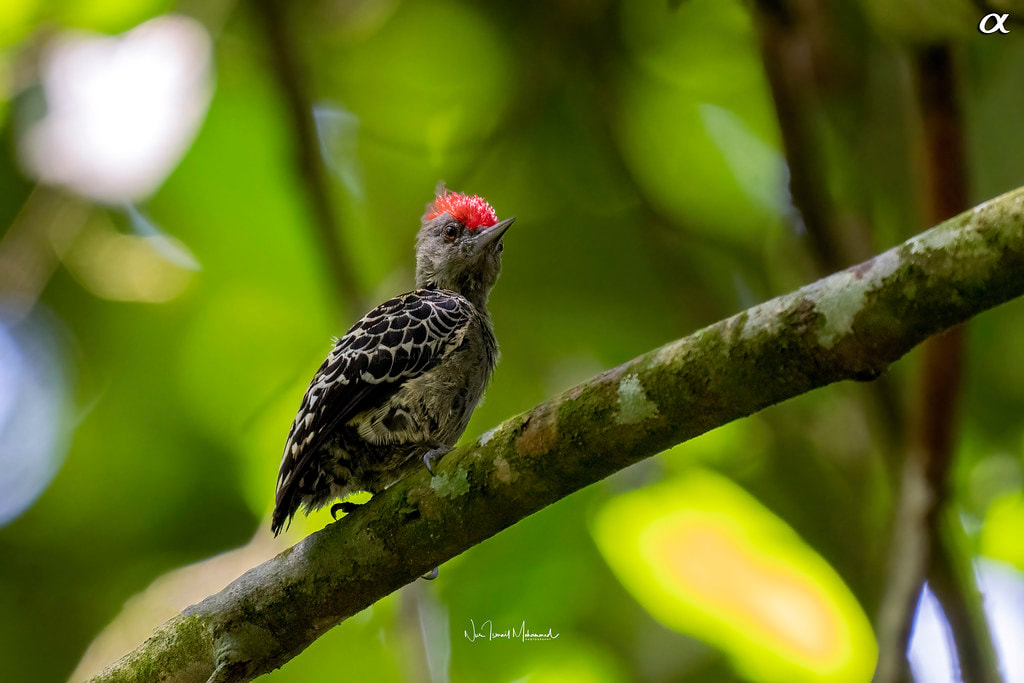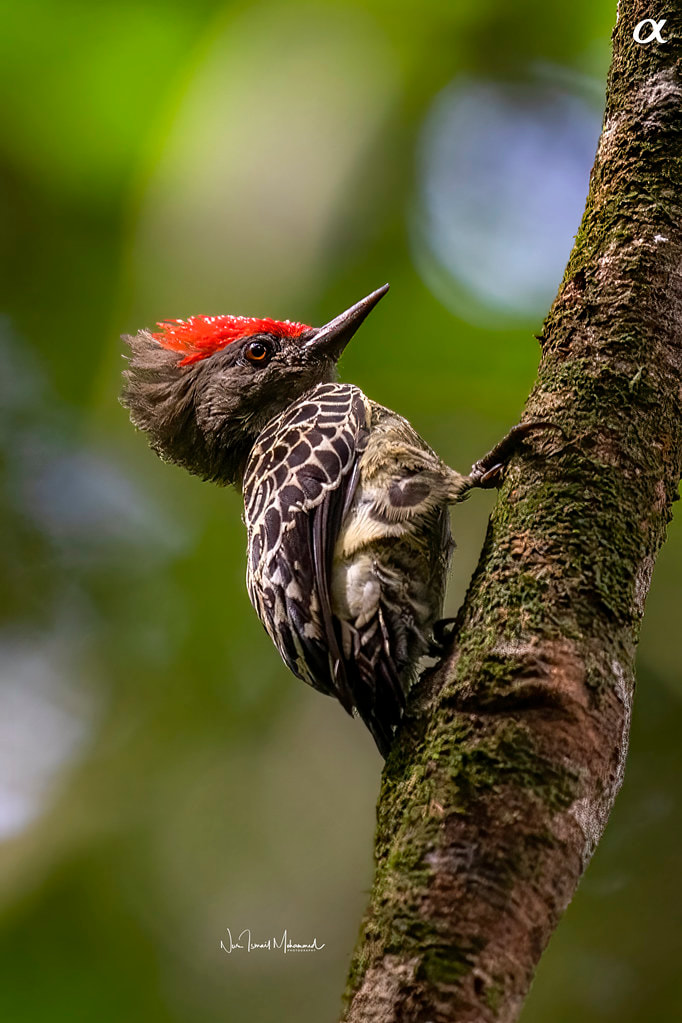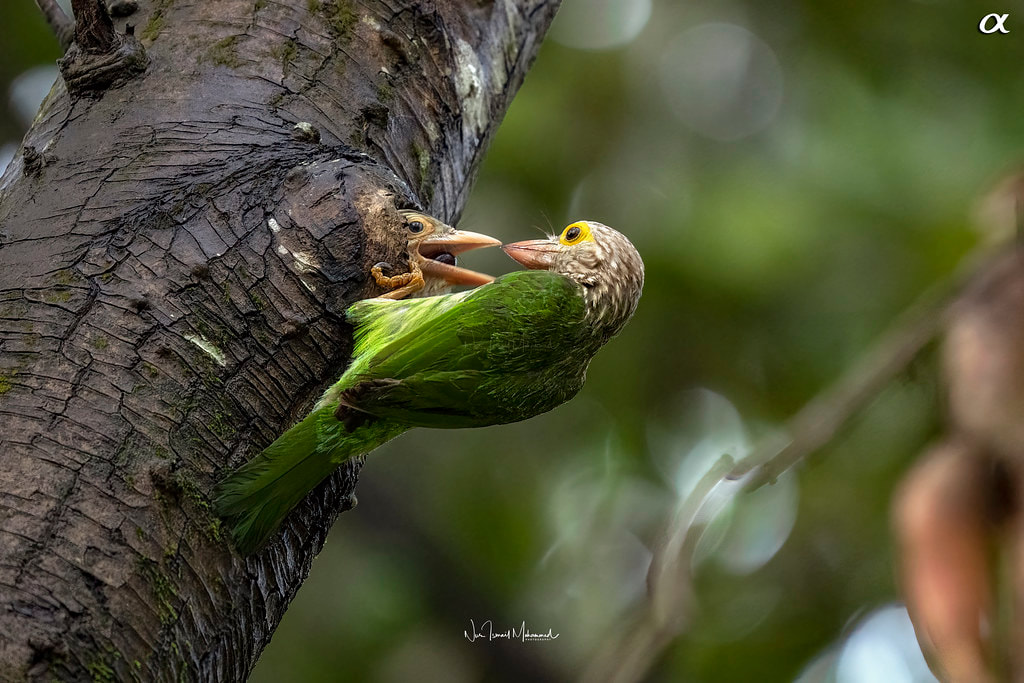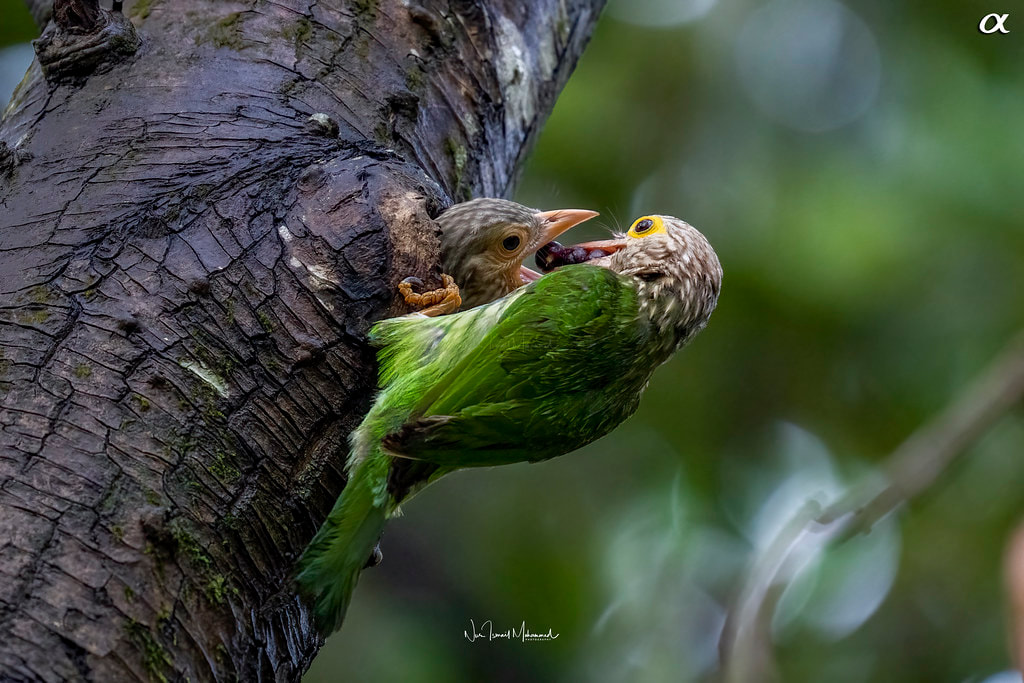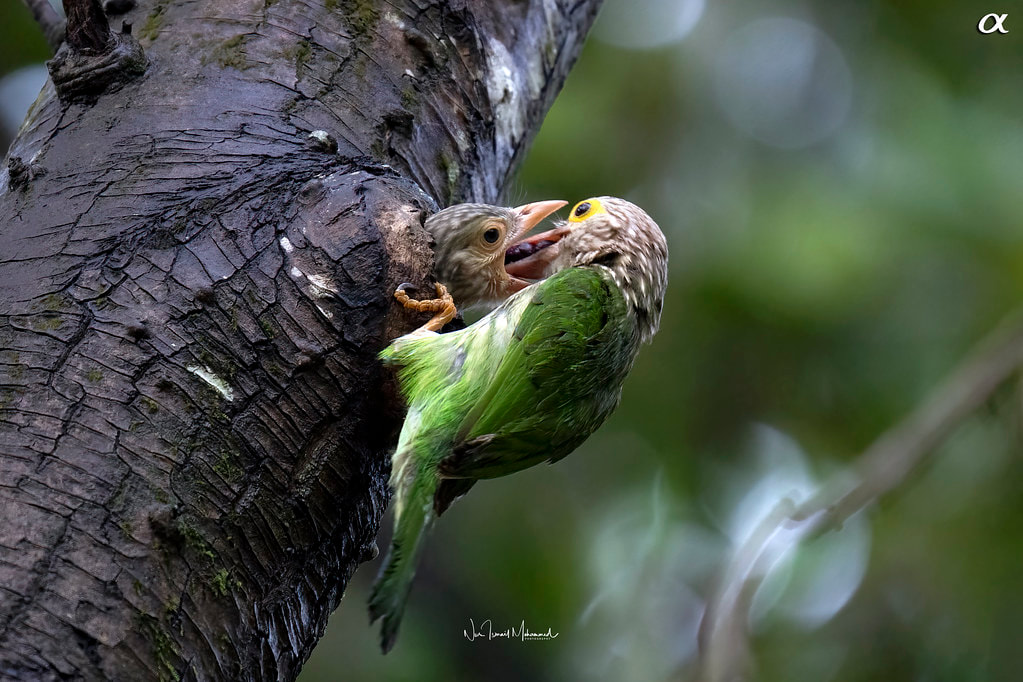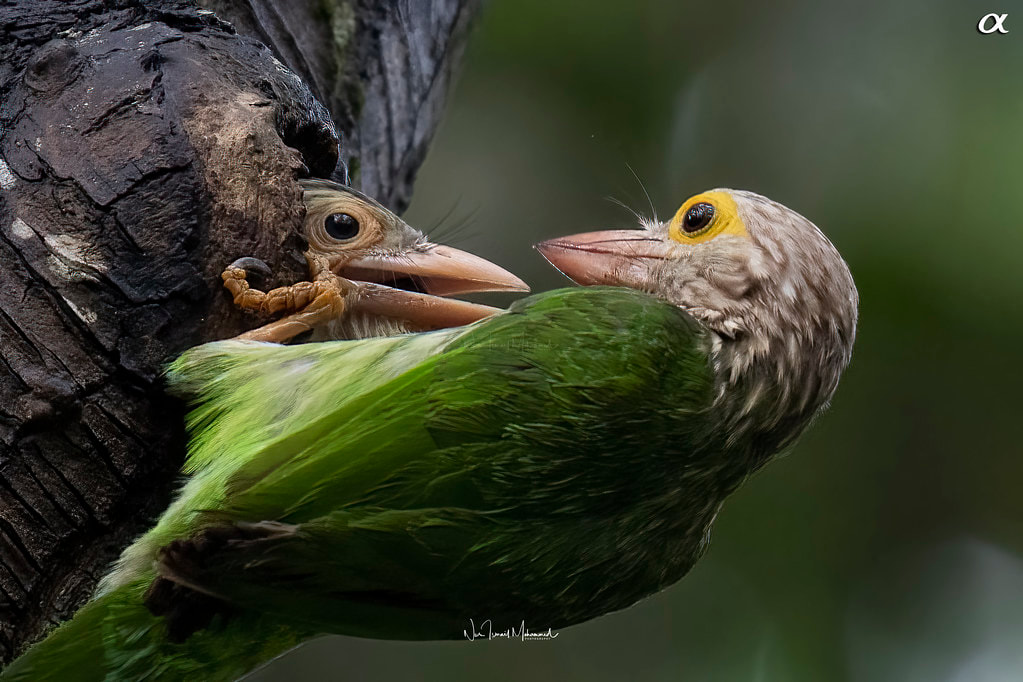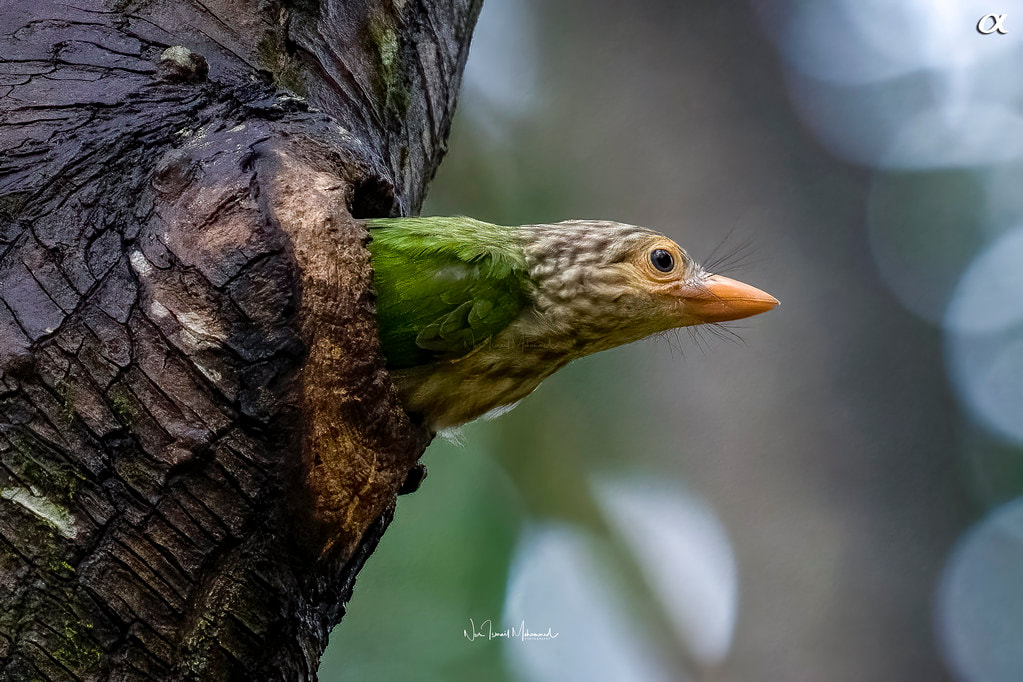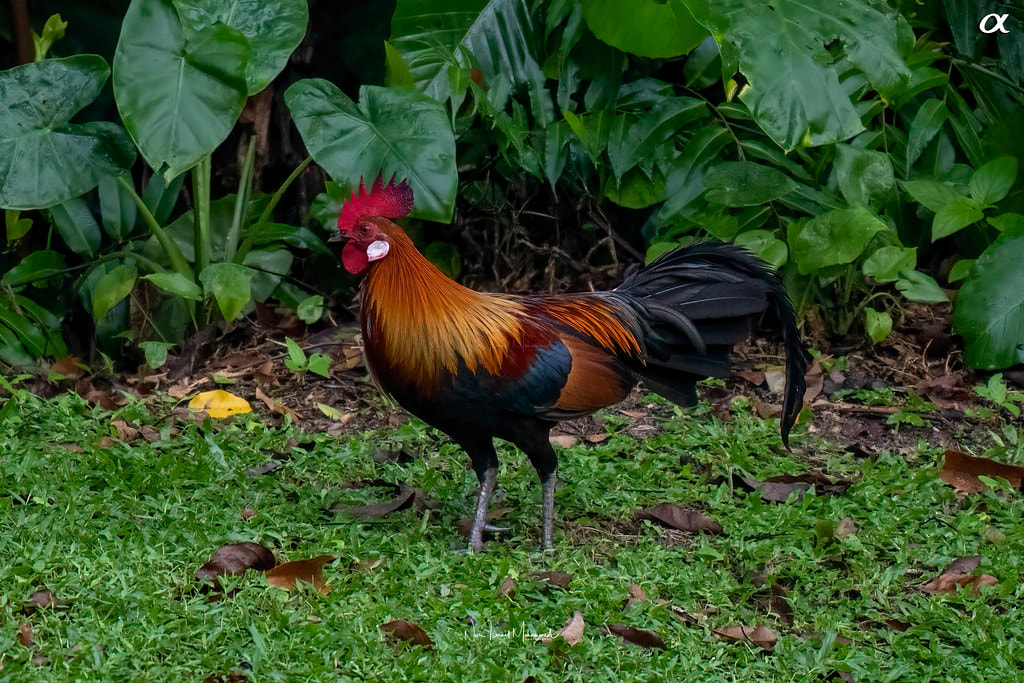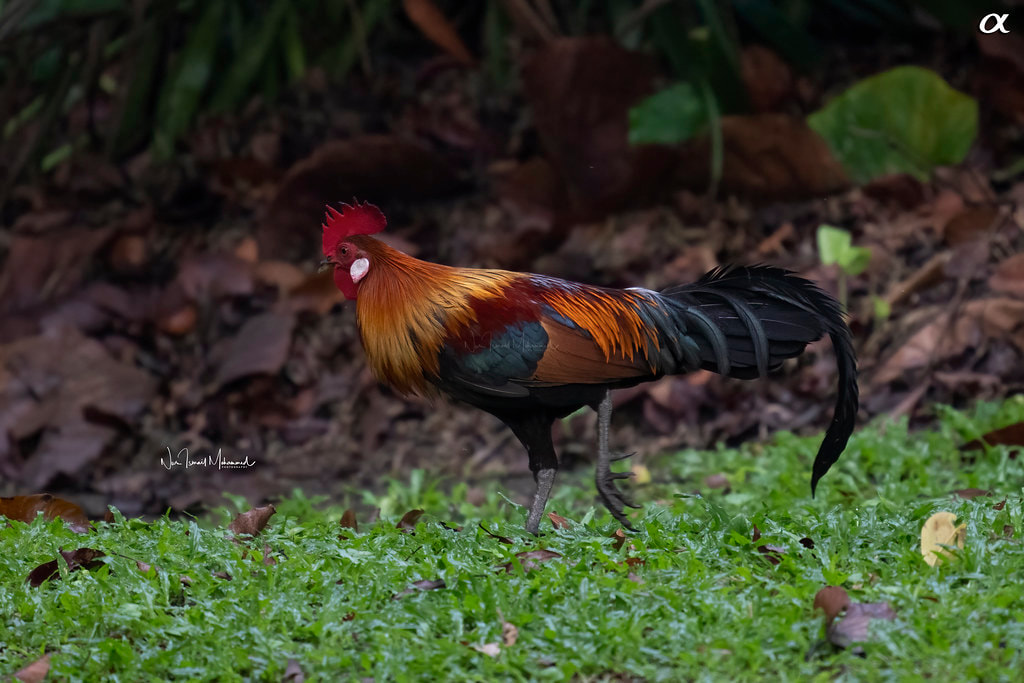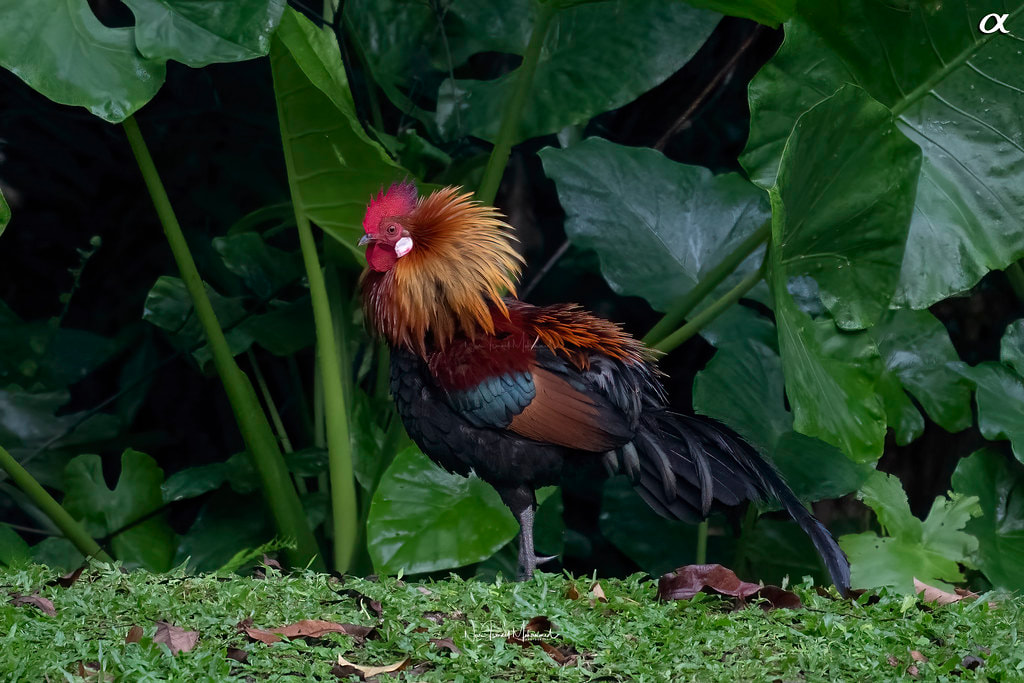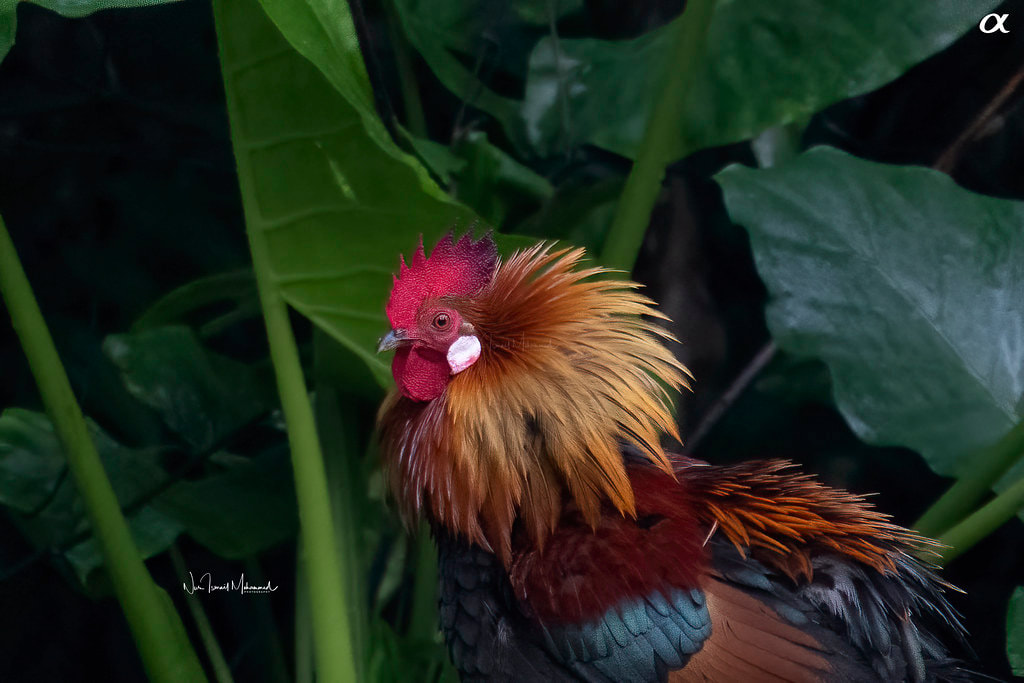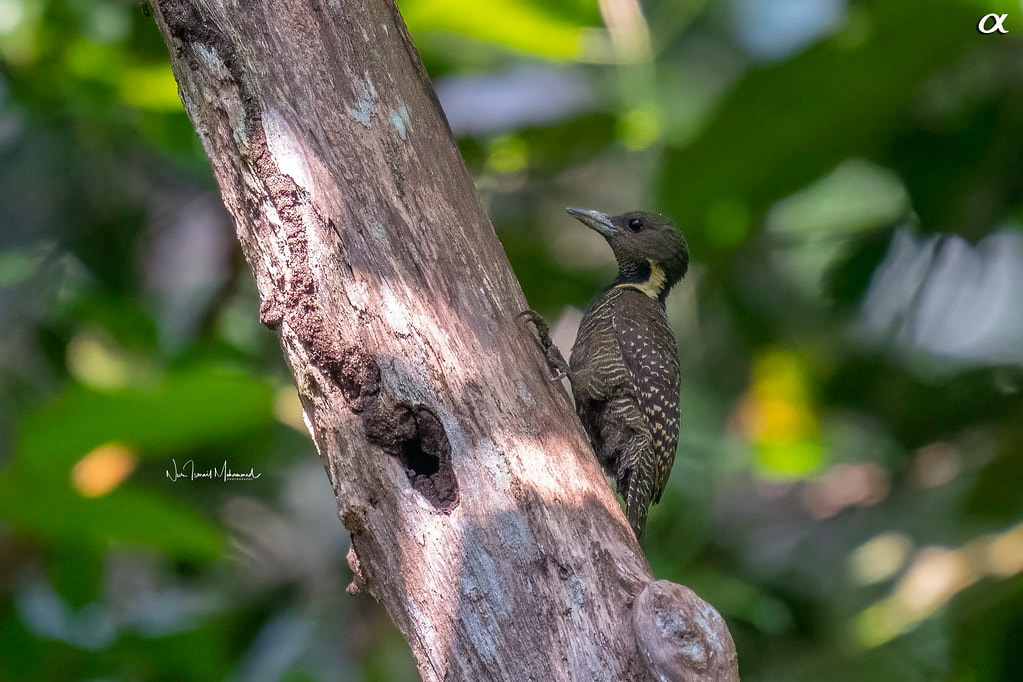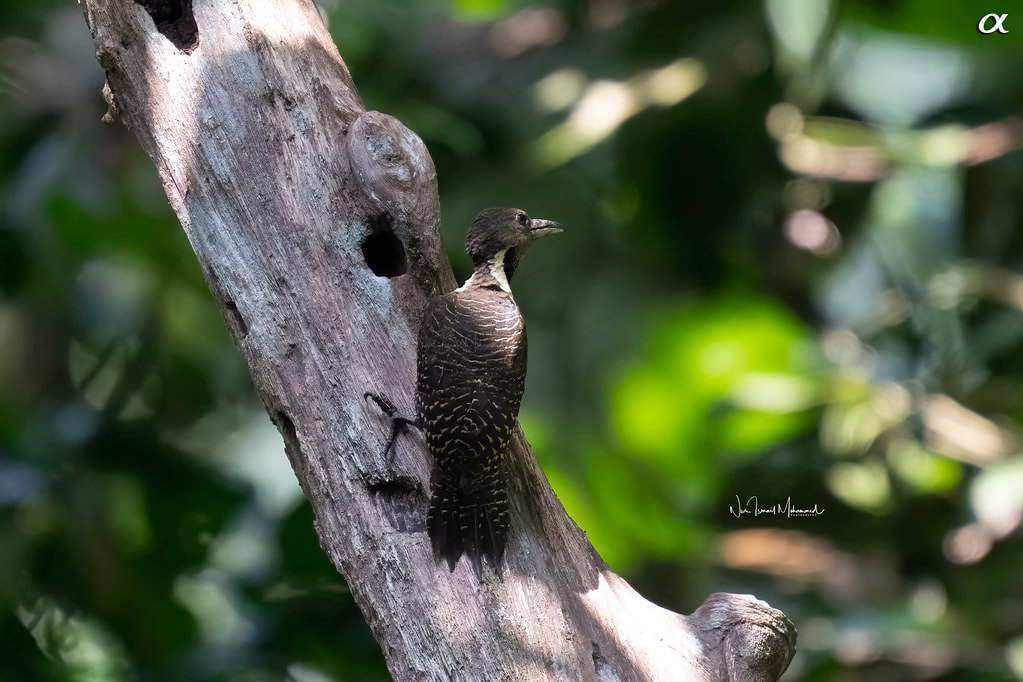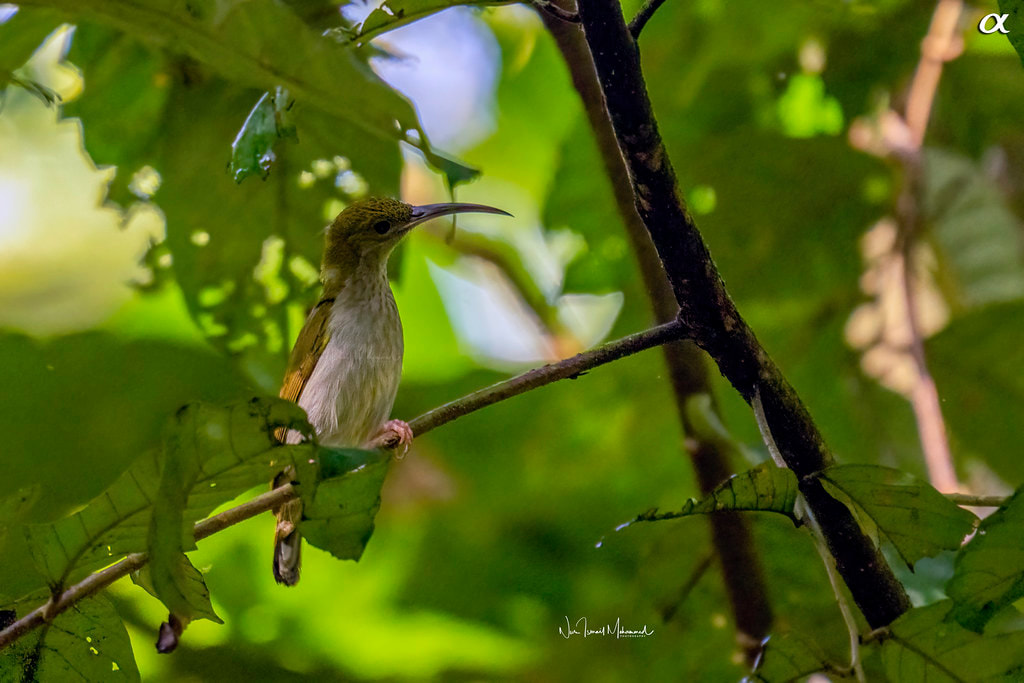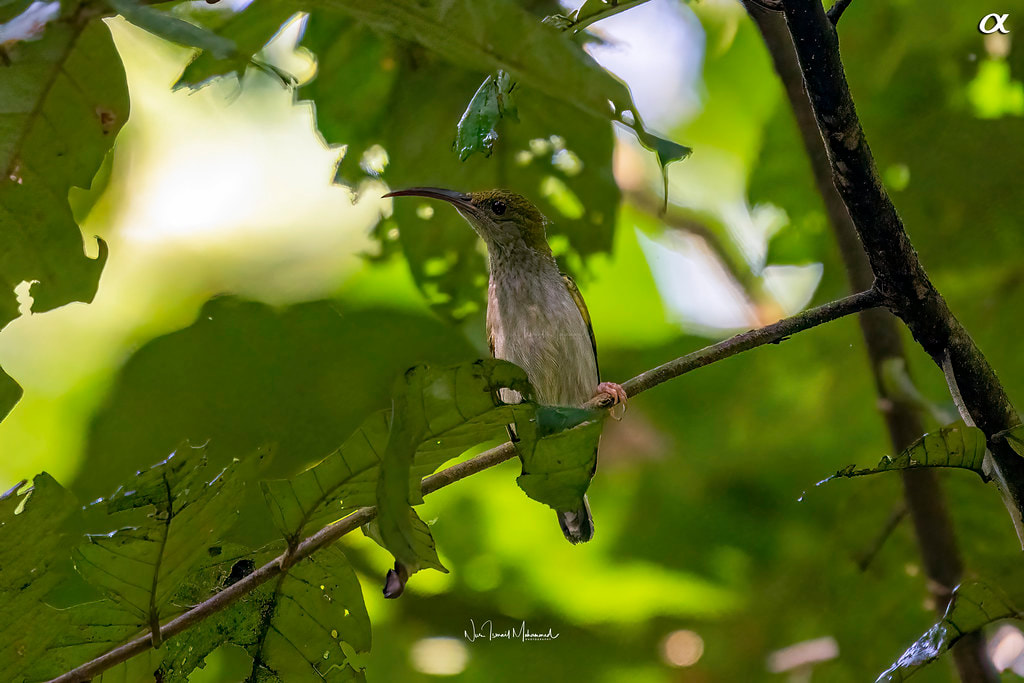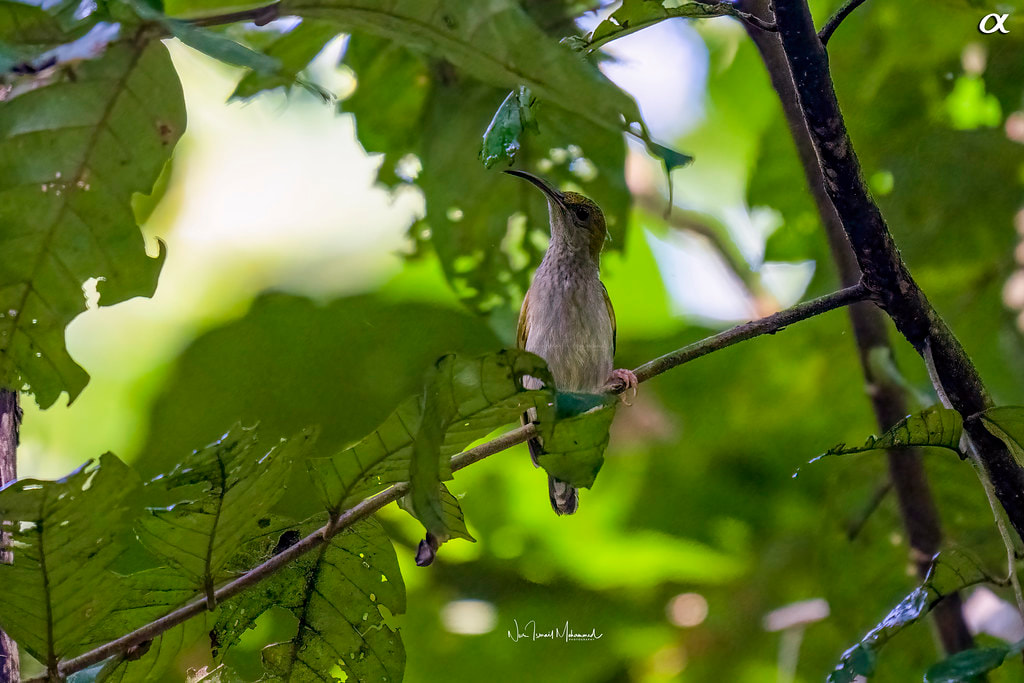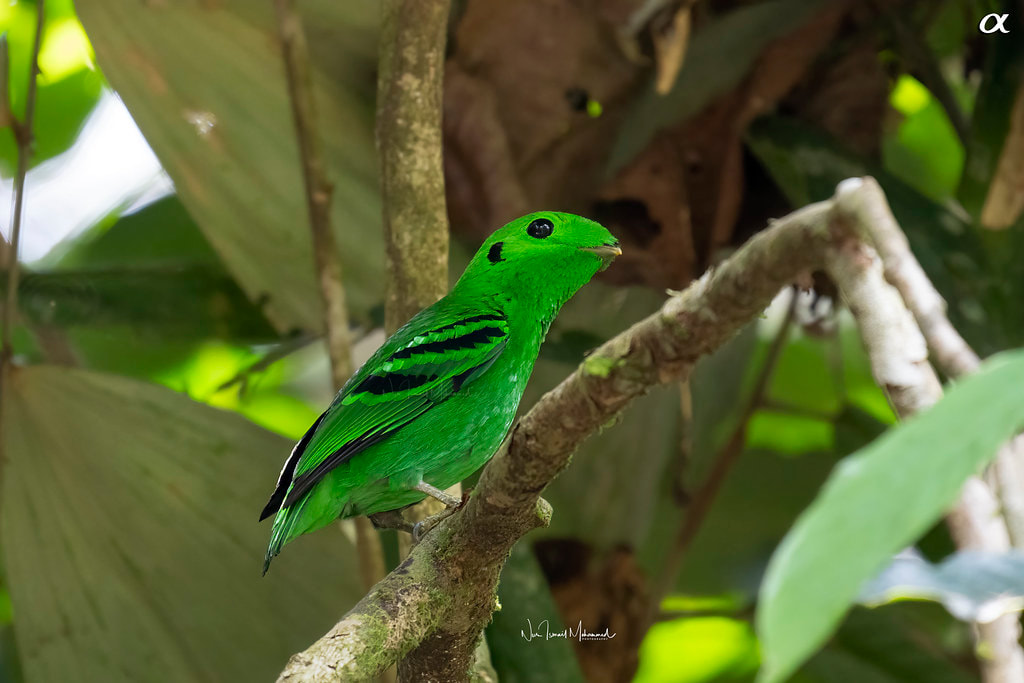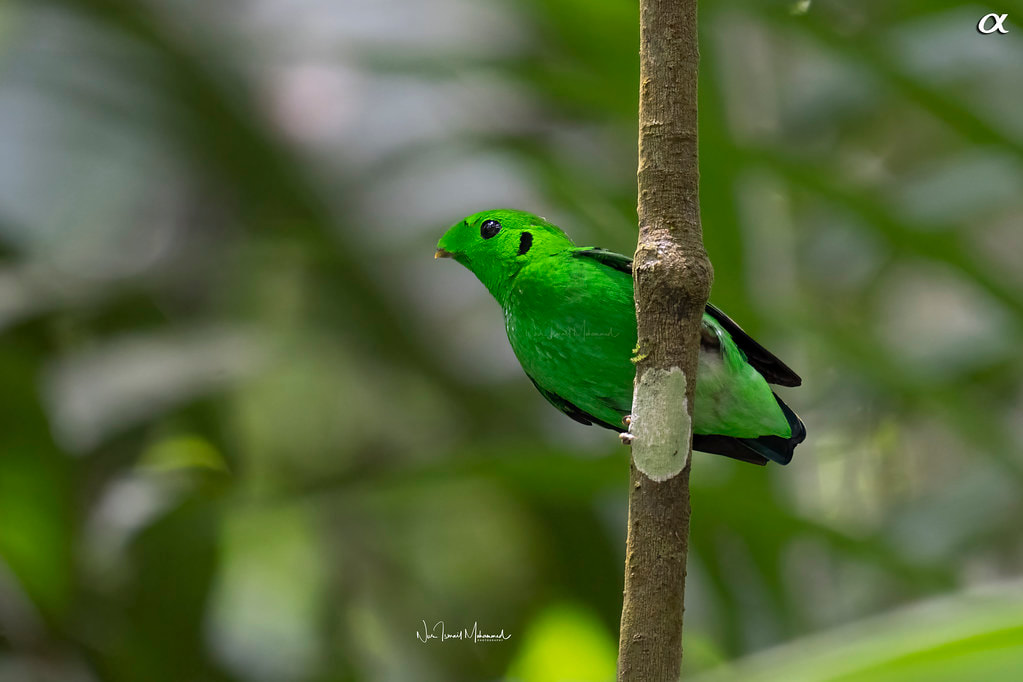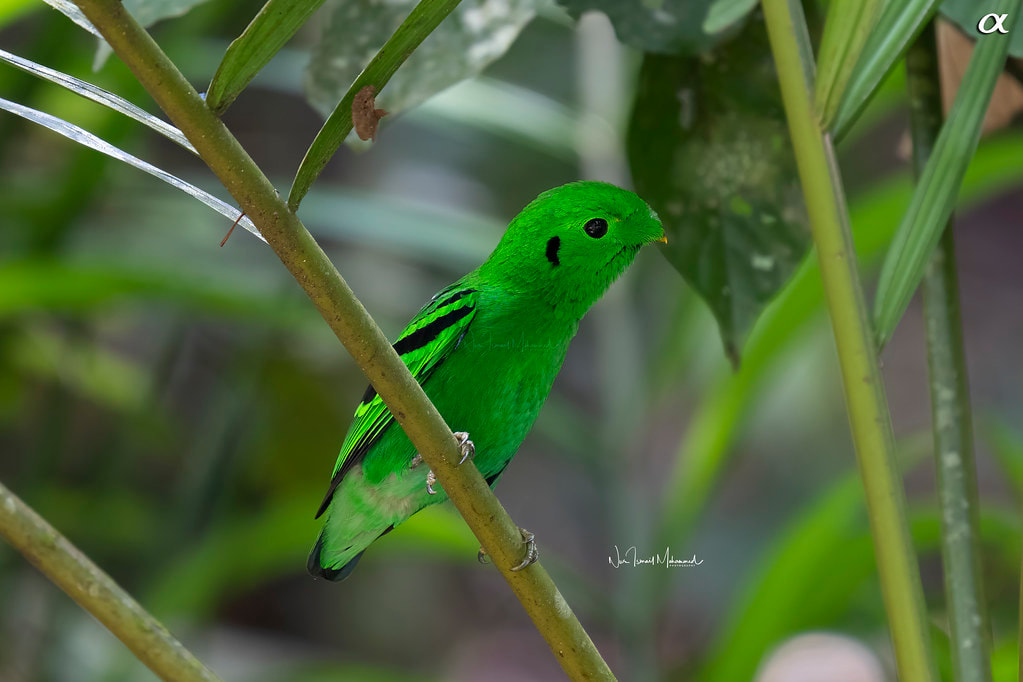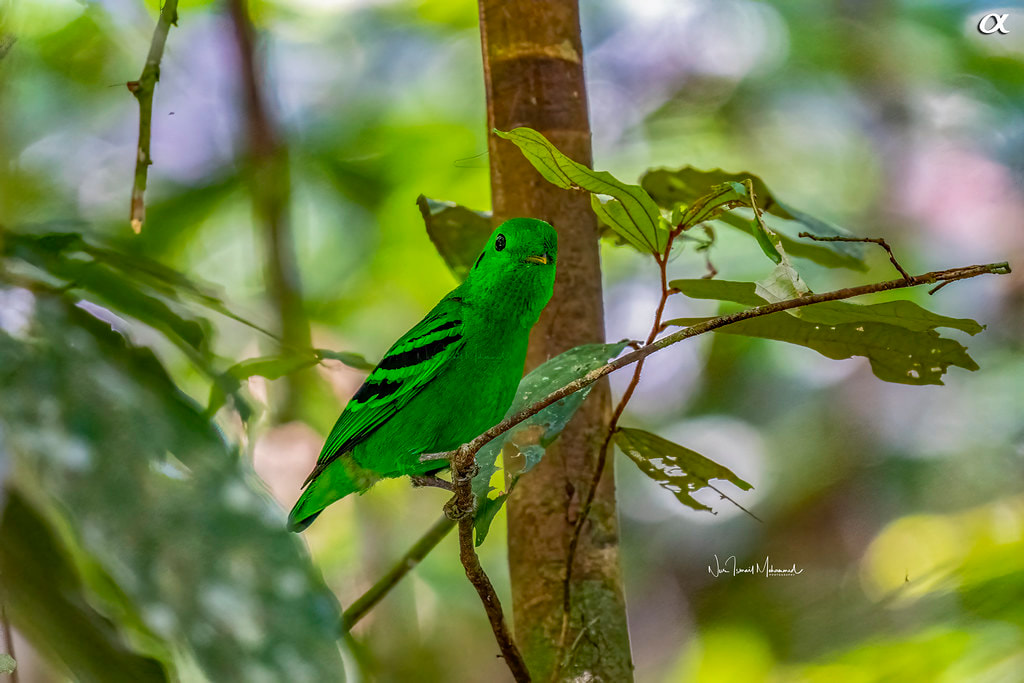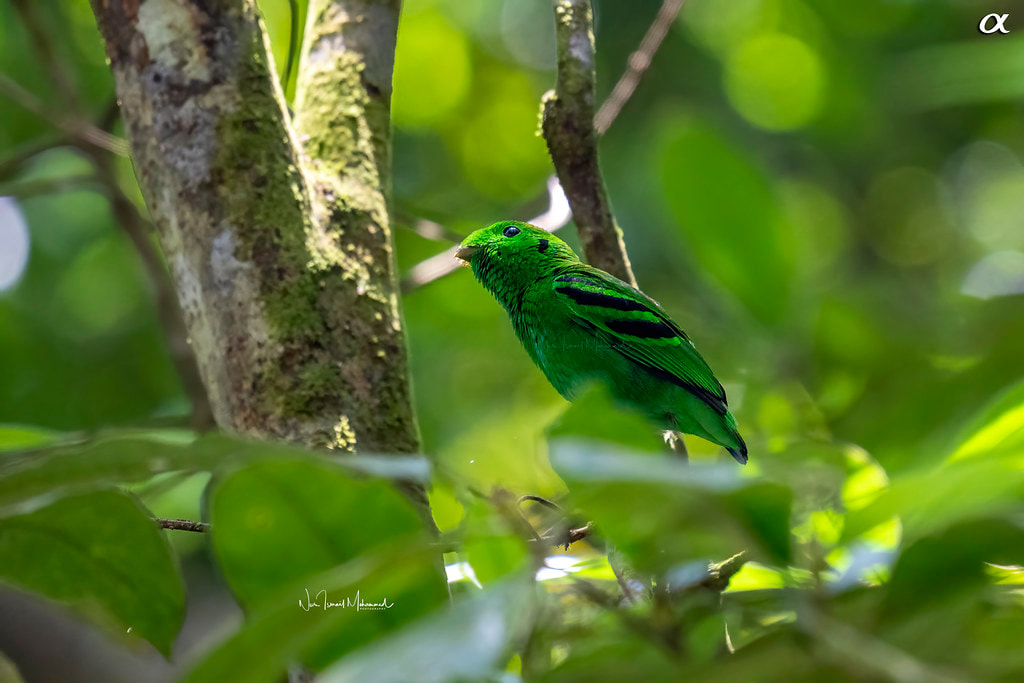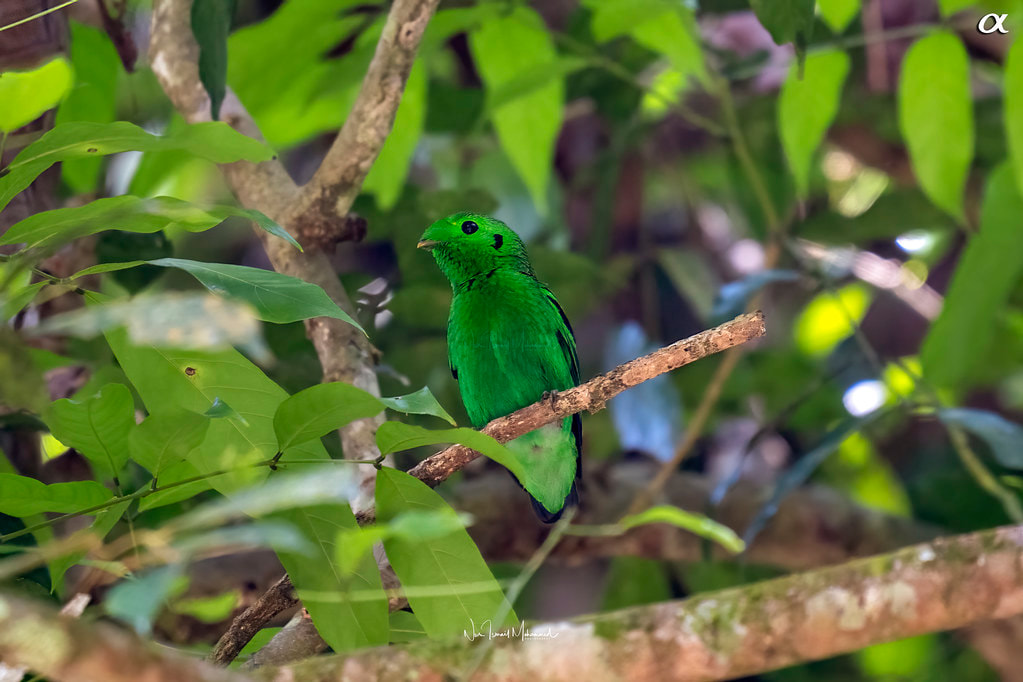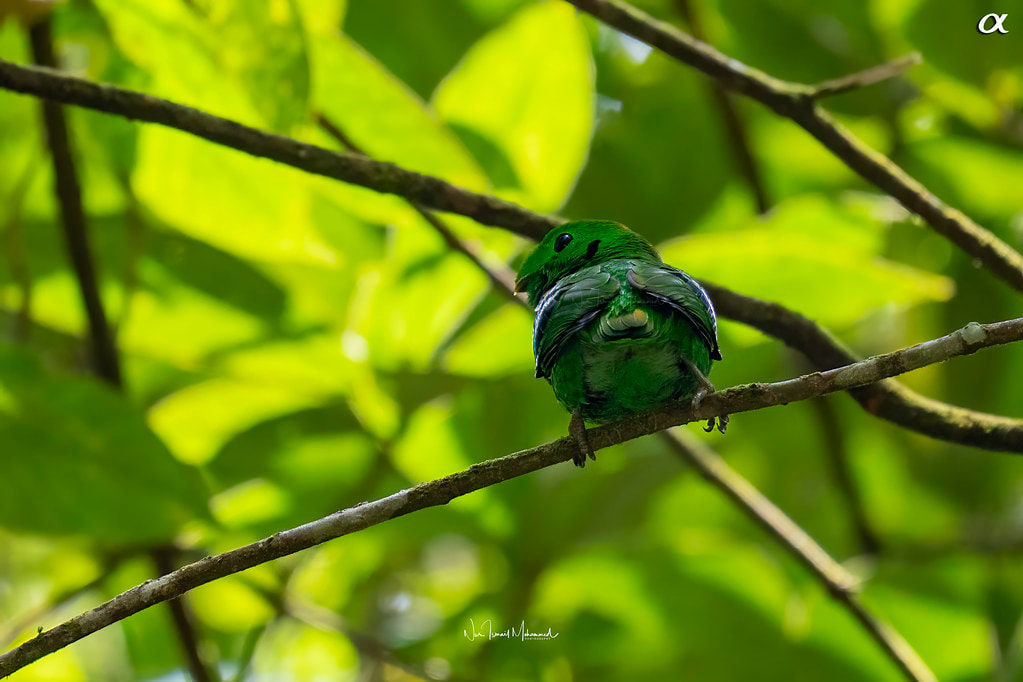|
Banded bay cuckoo (Cacomantis sonneratii) is a species of bird in the Cuculidae family. They are found in well-wooded forests, mainly in hill areas. It feeds on insects, especially caterpillars, bugs and grasshoppers. Both sexes are alike. The adult has bright rufous or bay on the head and back, which is broadly barred with dark brown and whitish creamy underparts with brown streaks. A whitish supercilium is distinctive above a dark eye-line. The bill is long and slightly curved, the wing is darker and the tail is graduated with a dark brown centre. The tail has a subterminal black band and white tips to the feathers. The juvenile is similar but has a pale lower mandible and white fringes to the feathers of the upper body. This cuckoo is parasitic on the common iora (Aegithina tiphia) because it lays its eggs in the nest of the iora and the adult iora will feed the cuckoo fledgling. [Source: MyBIS] I was blessed to be able to witness the said feeding of this banded bay cuckoo fledgling by the adult common iora, in between monitoring the hoopoe. It was a sight that I'm unable to describe. It is truly Allah's great creation in the circle of life. Name: Banded bay cuckoo Scientific: Cacomantis sonneratii Malay: Burung Takuweh / Sewah Berjalur / Sewah Takuweh Family: Cuculidae IUCN Red List (v.3.1, 2016): Least concern Gear: SONY a1 + SEL200600G. Location: Taiping, Perak. #FullFrameLife #MySONYLife #sony #sonymalaysia #a1 #SEL200600G #alpha #AlphaGuru #SAG #NurIsmailPhotography #madebyluminar #skylum #skylummalaysia #luminar #topazlabs #rmco #leofoto #pg1 #Fight4ourPlanet #DiscoverWithMYAlpha #DiscoverWithAlpha #AlphaUniverseMY #MBT #NeST
Copyright © 2021 Nur Ismail Photography. All rights reserved. Do not use or reproduce these images on websites, blogs or publications without expressed written permission from the photographer.
0 Comments
We are blessed to have a pair of the Eurasian hoopoe, for the first time, nesting at the Taiping Lake Gardens, just outside of Zoo Taiping & Night Safari. The hoopoe's nesting has attracted people from all around Perak to come and see the bird for themselves. In order to safeguard the safety of the nest and any untoward incidence, Taiping Municipal Council, the local authority and Zoo Taiping have placed security guards near the nests for round the clock surveillance. There are also currently constant monitoring of the behaviours and feeding of the hoopoe, which currently being done with collaboration of the Council, Zoo Taiping, Department of Wildlife and National Parks (PERHILITAN) & NESt (Nurture Educate Share Train), a Non-governmental organisation. I'm glad to be part of the group in monitoring the successful breeding of the hoopoe. As of today, we have observed that there are at least two chicks in the nest. More efforts are being put in place to ensure the safety of the hoopoe family. Stay tuned for the latest in this unprecedented hoopoe's nesting in Taiping. #FullFrameLife #MySONYLife #sony #sonymalaysia #a1 #SEL200600G #alpha #AlphaGuru #SAG #NurIsmailPhotography #madebyluminar #skylum #skylummalaysia #luminar #topazlabs #rmco #leofoto #pg1 #Fight4ourPlanet #DiscoverWithMYAlpha #DiscoverWithAlpha #AlphaUniverseMY #mbt #majlisperbandarantaiping #zootaiping #nightsafari #nest #perhilitan #selamatpagimalaysia #hudhud #hoopoe #rare #bird #nesting #tamantasiktaiping #taipinglakegarden #taipingperak #tourismperak
Copyright © 2021 Nur Ismail Photography. All rights reserved. Do not use or reproduce these images on websites, blogs or publications without expressed written permission from the photographer. Dinopium javanense is a species of bird belonging to the Picidae family (woodpeckers). This species is known as Common Flameback or Common Goldenback and is found in plantations, coconut and scattered woodland in lowlands. Its natural habitats are subtropical or tropical dry forests, moist lowland forests, and mangrove forests. The Common Flameback can easily be distinguishable by its golden back feathers and its red rump with the male exhibiting a flaming red crown, while the female has an all-black crown with white-streaked (Strange & Jeyarajasingam, 1993). Both sexes have black eyestripes joined to the black rear neck stripe and black-scaled white underparts and red rump contrasting with the black tail. It also has a small bill and only has three toes. The greater flameback (Chrysocolaptes lucidus) looks quite similar to this species. Its diets are including fruits like Rambutan (Nephelium lappaceum), Chempedak (Artocarpus integer) and insects like alate termites. [Source: MyBIS] Taking some time during the Nuzul Quran holiday to bird and bump into some birding buddies, Mat Jo & Bip. The activity was very low today. Perhaps when the nestlings have hatched, then there will be more trips by the parents to feed the chicks. Will definitely comeback for more. Good day! Name: Common flameback woodpecker (male) Scientific: Dinopium javanense Malay: Belatuk Pinang Muda / Belatuk Emas / Belatuk Pinang Kecil / Belatuk Pinang Tua Kecil Family: Picidae IUCN Red List (v3.1, 2016): Least Concern Gear: SONY a1 + SEL200600G. Location: Kuala Lumpur. #FullFrameLife #MySONYLife #sony #sonymalaysia #a1 #SEL200600G #alpha #AlphaGuru #SAG #NurIsmailPhotography #madebyluminar #skylum #skylummalaysia #luminar #topazlabs #leofoto #pg1 #Fight4ourPlanet #DiscoverWithMYAlpha #DiscoverWithAlpha #AlphaUniverseMY
Copyright © 2021 Nur Ismail Photography. All rights reserved. Do not use or reproduce these images on websites, blogs or publications without expressed written permission from the photographer. Hoopoes (/ˈhuːpuː/) are colourful birds found across Africa, Asia, and Europe, notable for their distinctive "crown" of feathers. The Eurasian hoopoe (Upupa epops) is the most widespread species of the genus Upupa, native to Europe, Asia and the northern half of Africa. Some taxonomists still consider all three species conspecific. Some authorities also keep the African and Eurasian hoopoe together but split the Madagascar hoopoe. Three living and one extinct species are recognized, though for many years all of the extant species were lumped as a single species - Upupa epops. Upupa and epops are respectively the Latin and Ancient Greek names for the hoopoe; both, like the English name, are onomatopoeic forms which imitate the cry of the bird. Name: Eurasian hoopoe Scientific: Upupa epops Malay: Burung Hud-hud / Hupo Tunggal Family: Upupidae IUCN Red List (v3.1, 2020): Least Concern Gear: SONY a1 + SEL200600G. Location: Taiping, Perak. The Hoopoe, known as the hudhud (هُدْهُد), also appears with Prophet Sulaiman A.S. in the Quran in Surah Al-Naml: And [Sulaiman A.S.] took attendance of the birds and said, "Why do I not see the hoopoe – or is he among the absent? (20) I will surely punish him with a severe punishment or slaughter him unless he brings me clear authorization." (21) But he [i.e., the hoopoe] stayed not long and said, "I have encompassed [in knowledge] that which you have not encompassed, and I have come to you from Queen Balqis with certain news. (22) Indeed, I found [there] a woman ruling them, and she has been given of all things, and she has a great throne. (23) I found her and her people prostrating to the sun instead of Allah, and Satan has made their deeds pleasing to them and averted them from [His] way, so they are not guided [...]" (24) [Quran 27:20–24 (Translated by Sahih International)]. Hoopoes are monogamous, although the pair bond apparently only lasts for a single season. They are also territorial. The male calls frequently to advertise his ownership of the territory. Chases and fights between rival males (and sometimes females) are common and can be brutal. Birds will try to stab rivals with their bills, and individuals are occasionally blinded in fights. The nest is in a hole in a tree or wall and has a narrow entrance. It may be unlined, or various scraps may be collected. The female alone is responsible for incubating the eggs. Clutch size varies with location: Northern Hemisphere birds lay more eggs than those in the Southern Hemisphere, and birds at higher latitudes have larger clutches than those closer to the equator. In central and northern Europe and Asia the clutch size is around 12, whereas it is around four in the tropics and seven in the subtropics. The eggs are round and milky blue when laid, but quickly discolour in the increasingly dirty nest. They weigh 4.5 grams (0.16 oz). A replacement clutch is possible. Hoopoes have well-developed anti-predator defences in the nest. The uropygial gland of the incubating and brooding female is quickly modified to produce a foul-smelling liquid, and the glands of nestlings do so as well. These secretions are rubbed into the plumage. The secretion, which smells like rotting meat, is thought to help deter predators, as well as deter parasites and possibly act as an antibacterial agent. The secretions stop soon before the young leave the nest. From the age of six days, nestlings can also direct streams of faeces at intruders, and will hiss at them in a snake-like fashion. The young also strike with their bill or with one wing. The incubation period for the species is between 15 and 18 days, during which time the male feeds the female. Incubation begins as soon as the first egg is laid, so the chicks are born asynchronously. The chicks hatch with a covering of downy feathers. By around day three to five, feather quills emerge which will become the adult feathers. The chicks are brooded by the female for between 9 and 14 days. The female later joins the male in the task of bringing food. The young fledge in 26 to 29 days and remain with the parents for about a week more. [Source: Wikipedia]. We are blessed to have a pair of the Eurasian hoopoe, for the first time, nesting at the Taiping Lake Gardens, just outside of Zoo Taiping & Night Safari. The hoopoe's nesting has attracted people from all around Perak to come and see the bird for themselves. In order to safeguard the safety of the nest and any untoward incidence, Taiping Municipal Council, the local authority and Zoo Taiping have placed security guards near the nests for round the clock surveillance. There are also currently constant monitoring of the behaviours and feeding of the hoopoe, which currently being done with collaboration of the Council, Zoo Taiping, Department of Wildlife and National Parks (PERHILITAN) & NESt (Nurture Educate Share Train), a Non-governmental organisation. I'm glad to be part of the group in monitoring the successful breeding of the hoopoe. Here are some of the footage of the hoopoe that I would like to share. #FullFrameLife #MySONYLife #sony #sonymalaysia #a1 #SEL200600G #alpha #AlphaGuru #SAG #NurIsmailPhotography #madebyluminar #skylum #skylummalaysia #luminar #topazlabs #rmco #leofoto #pg1 #Fight4ourPlanet #DiscoverWithMYAlpha #DiscoverWithAlpha #AlphaUniverseMY #mbt #majlisperbandarantaiping #zootaiping #nightsafari #nest #perhilitan #selamatpagimalaysia #hudhud #hoopoe #rare #bird #nesting #tamantasiktaiping #taipinglakegarden #taipingperak #tourismperak
Copyright © 2021 Nur Ismail Photography. All rights reserved. Do not use or reproduce these images on websites, blogs or publications without expressed written permission from the photographer. Hemicircus concretus is a small crested and short-tailed woodpecker measuring around 13 cm long and is normally known as the grey-and-buff woodpecker. It has black upperparts with pale yellowish scale and white rump. Its head and underparts are greyish, while the bill is dark grey. To differentiate between both sexes, the male woodpecker has a diagnostic red crown. This species occurs from Myanmar to Malay Peninsula and the Greater Sundas and is locally common in lowlands and hilly primary and secondary forests and plantations. Usually, the grey-and-buff woodpecker gleans for insects in pairs. [Source: MyBIS] Name: Grey-and-buff woodpecker (male) Scientific: Hemicircus concretus Malay: Belatok Punggoh / Belatuk Kecil Berjambul / Belatuk Kecil Kepala Kelabu / Belatuk Kelabu Dan Kuning Langsat Family: Picidae IUCN Red List (v3.1, 2016): Least Concern Gear: SONY a1 + SEL200600G + SEL14TC. Location: Hulu Langat, Selangor. #FullFrameLife #MySONYLife #sony #sonymalaysia #a1 #SEL200600G #SEL14TC #alpha #AlphaGuru #SAG #NurIsmailPhotography #madebyluminar #skylum #skylummalaysia #luminar #topazlabs #leofoto #pg1 #Fight4ourPlanet #DiscoverWithMYAlpha #DiscoverWithAlpha #AlphaUniverseMY
Copyright © 2021 Nur Ismail Photography. All rights reserved. Do not use or reproduce these images on websites, blogs or publications without expressed written permission from the photographer. Psilopogon lineatus is a medium-sized barbet measuring around 29 cm in length. It is commonly known as lineated barbet in English and Takur Kukup in Malay. It has a green body and the bill is pale straw coloured with light brown head and buff streak. Lineated barbet is distributed within the oriental region, which occurs in the Himalayas through Myanmar and the Malay Peninsular to Java and Bali. It is often found in coastal scrubs, orchards, coconut groves and tall secondary forests. Usually, lineated barbet feeds solitarily in fruiting trees and nests in a tree cavity. As of today, two chicks have fledged successfully and there is one more chick still in the nest. The circle of life continues. Name: Lineated barbet Scientific: Psilopogon lineatus Malay: Takur Kukup / Takur Dada-berjalur Family: Megalaimidae IUCN Red List (v.3.1, 2016): Least Concern Gear: SONY a1 + SEL200600G. Location: Kuala Lumpur. #FullFrameLife #MySONYLife #sony #sonymalaysia #a1 #SEL200600G #alpha #AlphaGuru #NurIsmailPhotography #madebyluminar #skylum #skylummalaysia #luminar #topazlabs #urbanbirding #stayathome #leofoto #pg1 #Fight4ourPlanet #DiscoverWithMYAlpha #DiscoverWithAlpha #AlphaUniverseMY
Copyright © 2021 Nur Ismail Photography. All rights reserved. Do not use or reproduce these images on websites, blogs or publications without expressed written permission from the photographer. The Red junglefowl (Gallus gallus) is the primary ancestor of all domestic breeds of chicken. The male has bright orange yellow neck, orangey red back and black tail with greenish metalic sheen. As for the female, the neck is yellow with dark streaks and olive-brown underparts and upperparts. Both sexes have dark greyish feet and white ear patches. In peninsular Malaysia, the Red junglefowl is commonly found in lowland forest as well as the oil palm plantations. It’s often moves around in flocks consisting of largely females and juveniles. This species feeds on grubs and different kinds of grains found on the ground (Strange & Jeyarajasingam, 1993; Gautier, 2002). [Source: MyBIS] Name: Red junglefowl (male) Scientific: Gallus gallus Malay: Ayam Hutan / Ayam Beroga Family: Phasianidae IUCN Red List (v3.1, 2016): Least Concern Gear: SONY a1 + SEL200600G. Location: Kuala Lumpur. #FullFrameLife #MySONYLife #sony #sonymalaysia #a1 #SEL200600G #alpha #AlphaGuru #SAG #NurIsmailPhotography #madebyluminar #skylum #skylummalaysia #luminar #topazlabs #rmco #leofoto #pg1 #Fight4ourPlanet
Copyright © 2021 Nur Ismail Photography. All rights reserved. Do not use or reproduce these images on websites, blogs or publications without expressed written permission from the photographer. Buff-necked Woodpecker or scientifically known as Meiglyptes tukki, is a small woodpecker that can grow up 22 cm in length. It can be identified by its short blackish bill, uniform dark brown plumage together with narrow buff bars on mantle, wings, tails and entire underparts as well as buff neck patch. The male has red malar stripe while the female don’t have it. They are common in lowland and hill forests. It can be found in Sundaland, which covers from Myanmar, Malay Peninsula to Sumatra and Borneo. Their primary diet consists of ants and termites. Often this woodpecker will forage with other species flocks like Buff-rumped Woodpecker, Greater raket-tailed Drongo and Raffles Malkoha. The rapid rate of forest loss due illegal logging and land conversion is the main threat for the decline of this woodpecker. [Source: MyBIS]. Name: Buff-necked woodpecker Scientific: Meiglyptes tukki Malay: Belatok Tuki-tuki / Belatuk Leher Kuning / Belatuk Leher Kuning Langsat / Belatuk Tuki-tuki Family: Picidae IUCN Red List (v3.1, 2016): Near Threatened Gear: SONY a1 + SEL200600G + SEL14TC. Location: Hulu Langat, Selangor. #FullFrameLife #MySONYLife #sony #sonymalaysia #a1 #SEL200600G #SEL14TC #alpha #AlphaGuru #SAG #NurIsmailPhotography #madebyluminar #skylum #skylummalaysia #luminar #topazlabs #leofoto #pg1 #Fight4ourPlanet #DiscoverWithMYAlpha #DiscoverWithAlpha #AlphaUniverseMY
Copyright © 2021 Nur Ismail Photography. All rights reserved. Do not use or reproduce these images on websites, blogs or publications without expressed written permission from the photographer. Grey-breasted Spiderhunter (Arachnothera affinis) is a species of bird, locally known as Kelicap dada kelabu. It has a long sickle shaped bill, short tail, olive-green upperparts and grey underparts with dark streaks on its throat and breast. Its body measures around 18 cm in length (Strange & Jeyarajasingam, 1993; Jeyarajasingam & Pearson, 2012). This bird is endemic throughout the Sundaland where it can be found in Brunei, Indonesia and Malaysia (BirdLife International, 2016). In Peninsular Malaysia, it is known to inhabit the middle and lower storey of lowland rainforest, especially where the bananas and ginger are found. It can also be seen at flowering trees or shrubs at the forest edges and overgrown plantations near the forest edge (Strange & Jeyarajasingam, 1993; Jeyarajasingam & Pearson, 2012). [Source: MyBIS] Name: Grey-breasted spiderhunter Scientific: Arachnothera affinis Malay: Kelicap Dada Kelabu / Kelicap Jantong Bukit / Kelicap Jantung Bukit / Kelicap-sabit Dada Kelabu Family: Nectariniidae IUCN Red List (v.3.1, 2018): Least Concern Gear: SONY a1 + SEL200600G + SEL14TC. Location: Hulu Langat, Selangor. #FullFrameLife #MySONYLife #sony #sonymalaysia #a1 #SEL200600G #SEL14TC #alpha #AlphaGuru #NurIsmailPhotography #madebyluminar #skylum #skylummalaysia #luminar #topazlabs #urbanbirding #stayathome #leofoto #pg1 #Fight4ourPlanet #DiscoverWithMYAlpha #DiscoverWithAlpha #AlphaUniverseMY
Copyright © 2021 Nur Ismail Photography. All rights reserved. Do not use or reproduce these images on websites, blogs or publications without expressed written permission from the photographer. Asian Green Broadbill or Takau Hijau in Malay is a small bird measuring about 19 cm long. It has a chunky and plump body, with a short tail and a large head.Its short beak almost covered by the green feathers (Strange & Jeyarajasingam, 1993). Takau Hijau can be found in lowland forests, in the middle and lower storeys, and often near the rivulets. It has an excellent camouflage and is difficult to spot among leaves. Both male and female has nearly same appearance except in some part. The male species has a fully emerald green plumage and has markings of black dots behind each of its ears, on its wings and neck, while the female is slightly dull and does not have black spots on its neck. This species feeds largely on soft figs. It is often overlooked, as it sits motionless inside the canopy or just below, quickly flying to a new location if disturbed. Its foliage-green color provides excellent camouflage. It feeds largely on soft figs. The broadbill's feeding habits helps to distribute the seeds of the fig around the forest floor. The female usually lays between two and three whitish eggs, and the young fledge after twenty-two to twenty-three days. Due to continuing habitat loss, the green broadbill is evaluated as Near Threatened on the IUCN Red List of Threatened Species. [Source: MyBIS & Wikipedia] Name: Green broadbill Scientific: Calyptomena viridis Malay: Burung Seluwit / Takau Hijau / Takau Rimba Hujan / Takau Selawit Family: Calyptomenidae IUCN Red List (v3.1, 2016): Near Threatened Gear: SONY a1 + SEL200600G + SEL14TC. Location: Hulu Langat, Selangor. #FullFrameLife #MySONYLife #sony #sonymalaysia #a1 #SEL200600G #SEL14TC #alpha #AlphaGuru #SAG #NurIsmailPhotography #madebyluminar #skylum #skylummalaysia #luminar #topazlabs #leofoto #pg1 #Fight4ourPlanet #DiscoverWithMYAlpha #DiscoverWithAlpha #AlphaUniverseMY
Copyright © 2021 Nur Ismail Photography. All rights reserved. Do not use or reproduce these images on websites, blogs or publications without expressed written permission from the photographer. |
AuthorThis is the photography journey of Nur Ismail Photography where all the experiences from this year onwards will be shared with the audience. In collaboration with NiSi Malaysia, Leofoto, SONY Malaysia and Skylum Software. Thanks for viewing! Archives
August 2022
Categories |
